Is it easier or harder to run a business in 2018?
Running a Business in 2018: Welcome to the Future (It's Complicated!)
Spoiler alert: It's more complicated than ever to run a business in 2018. But why? Let's dive into the three big challenges facing today's entrepreneurs and marketers.
Challenge #1: Choice Overload
- The marketplace is a zoo: Everyone's selling everything
- Differentiating pros from amateurs? Good luck!
- More choices = more complex decisions for consumers
- Result: Anxiety-prone customers struggling to solve their problems
Pro Tip: Cut through the noise with laser-focused messaging and clear value propositions.
Challenge #2: The 8-Second Attention Span
- Meet your customer: Exasperated and impatient
- They expect you to be a mind reader (no pressure!)
- True story: I once got annoyed at an Uber driver for being 90 seconds late at 2 AM in a Lexus.
- FYI: The average UK consumer attention span is now just 8 seconds
Pro Tip: Hook them fast and deliver value instantly. You've got 8 seconds – make them count!
Challenge #3: Sky-High Expectations
- Customers want it all, and they want it now
- Blame our phones: We expect instant gratification
- One bad experience? They're gone in 30 seconds
- This applies to both B2B and B2C – no one's immune
Pro Tip: Exceed expectations at every touchpoint. Consistency is key!
The Competition Conundrum: More players are entering the game every day. How to stand out? Bring gifts! (Seriously, salespeople love swag.)
The Bottom Line: Running a business in 2018 is like playing 4D chess while juggling flaming torches. But fear not! Understanding these challenges allows you to adapt your strategy and thrive in this brave new world.
Remember: The future is now. Are you ready to level up?
HubSpot research
Competition Explosion: Welcome to the Startup Nation
🚀 Mind-Blowing Stat Alert 🚀 2016: 6-8 competitors 2018: 20 competitors on average
Yep, you read that right. In just two years, the competitive landscape has tripled! But why?
The Startup Revolution:
- It's easier than ever to launch a business
- Global phenomenon - startup fever is worldwide
- Technology has lowered barriers to entry
- Result: We're living in a "Startup Nation"
What This Means for You:
- Standing out is more complicated (but not impossible)
- Niche expertise is more valuable than ever
- Customer experience is your secret weapon
- Adaptability is your new superpower
Pro Tip: Arm yourself with data! Check out HubSpot Research (shoutout to Mimi Ang, who runs it) for a goldmine of statistics to inform your strategy.
The Bottom Line: More competitors mean more noise and more opportunities. The businesses that thrive will genuinely understand their customers and deliver exceptional value.
Are you ready to rise above the crowd?
A growth strategy
Starting vs. Scaling: The New Business Battleground
Then vs. Now: A Startup Story
1993:
- Cost to start: $400,000
- 75% spent on servers and email (yes, really!)
- Starting a company = Big Deal
2024:
- Cost to start: $50 (thanks, Arizona!)
- Free apps galore
- Everyone and their dog has a side hustle.
The Great Equalizer: Technology has democratized entrepreneurship and got an idea? Congrats, you're in business!
But Here's the Plot Twist: Starting a business is easy. Scaling? That's where things get interesting.
The Real Challenge: Scaling Up
- Requires expertise
- Demands adaptability
- Calls for a solid growth strategy
What's a Growth Strategy? It's your game plan for navigating the chaos of rapid expansion. Think of it as your business GPS in the startup jungle.
Key Components:
- Clear vision and goals
- Scalable processes
- Adaptable business model
- Customer-centric approach
- Data-driven decision making
Remember: In today's world, everyone can start. The winners are those who can scale.
Are you ready to level up from startup to scale-up?
A big mistake to avoid: Cold calling
Cold Calling: The Marketing Dinosaur You Need to Ditch
Let's talk about the elephant in the room: cold calling. Spoiler alert - it's time to hang up on this outdated practice.
Inbound vs. Outbound: A Tale of Two Strategies
Inbound Marketing: "A human approach of turning total strangers into table-pounding advocates."
- Builds strong customer relationships
- Converts at 9-11%
Cold Calling (AKA Outbound):
- Converts at a measly 1.6-2%
- That's 98% wasted effort, folks!
The Cold, Hard Truth About Cold Calling:
- People don't answer unknown numbers anymore
- It damages your brand
- It's ineffective in today's digital age
- It's soul-crushing for your sales team
Fun Fact: Remember the Yellow Pages? Neither does anyone else.
Why Cold Calling Persists:
- "We've always done it this way" mentality
- Fear of change
- Lack of alternatives (psst... there are better ways!)
The Bottom Line: In a world with choices, why choose a method that wastes 98% of your resources? It's time to warm up to more effective strategies.
Up Next: We'll explore how your sales team can engage prospects professionally, respectfully, and effectively - without the cold call chill.
Remember: Just because you can cold call doesn't mean you should. Your time (and sanity) are worth more than that!
The inbound revolution
The Inbound Revolution: Why 'Shelping' is the New Selling
Welcome to 2018, where cold calling is out and "shelping" is in. Let's break down the Inbound revolution that's changing the game.
Cold Calling: A Chilly Reception
- Efficacy? A frigid 1.6-2% (thanks, Trish Bertuzzi of The Bridge Group!)
- Risk factor? Higher than ever
- Cold call me? Congratulations, you've lost a customer for life
The Inbound Mindset: "Treat people like human beings"
- No more stranger danger
- Face-to-face etiquette applies online, too
- Spam emails and self-centred pitches? Hard pass
Why Inbound Works:
- Respect the customer's time and intelligence
- Builds relationships, not just transactions
- Aligns with modern buying behaviours
- Creates a positive brand experience
Introducing: Shelping Selling + Helping = Shelping
- Focus on solving problems, not pushing products
- Build trust through valuable interactions
- Create advocates, not just customers
The Inbound Revolution in Action:
- Content that educates and informs
- Personalized, timely interactions
- Value-first approach to sales
Remember: In a world of infinite options, how you sell is as important as what you sell. Choose shelping, and watch your business grow!
Are you ready to join the Inbound revolution?
What is 'Smarketing'?
Sales vs Marketing: A 38-Year Grudge Match
 Buckle up, folks! We're going down memory lane to explore the epic rivalry between Sales and Marketing. Spoiler alert: It wasn't pretty.
Buckle up, folks! We're going down memory lane to explore the epic rivalry between Sales and Marketing. Spoiler alert: It wasn't pretty.
The Classic Divide:
Sales:
- Testosterone-fueled battleground
- Mission: Crush competitors, close deals
- Mindset: "We are the kings of revenue!"
Marketing:
- The helpful (but overlooked) sidekick
- Mission: Create brand awareness, generate leads
- Mindset: "We just want to help... please notice us!"
The Budget Battle:
- Sales: "Give me all the money!"
- Marketing: "But we need resources too..."
- Result: Sales 1, Marketing 0
The Blame Game:
- Not enough leads? Marketing's fault!
- Too many low-quality leads? Still Marketing's fault!
- Marketing's response: Nervous shoe-gazing
The ROI Inquisition: Scene: Annual board meeting Marketing VP: "Well, you see, it's complicated..." Board: "So, can we cut your budget by 20%?"
The Vicious Cycle:
- Marketing struggles to prove value
- Budget gets slashed
- Results suffer
- Repeat
The Big Question: Is this adversarial relationship the best way to drive business growth?
Stay tuned as we explore how modern businesses are breaking this dysfunctional cycle and embracing a new era of collaboration!
Is marketing an expense?
From Expense to Essential: Marketing's Dramatic Makeover
Once upon a time, marketing was the ugly stepchild of the business world. But times, they are a-changin'! Let's explore how marketing went from money pit to money maker.
The Old School Playbook:
- Marketing budget: A measly 5%
- Sales: Hogging 95% of the glory (and budget)
- Growth strategy: Hire more salespeople!
The Outdated Sales Dance:
- Get a lead (thanks, Marketing!)
- "Are you the decision-maker?" (Cringe)
- Qualify on the connect call (Yawn)
- Product demo (Features, features, features!)
- Handle objections (But wait, there's more!)
- Close, close, close!
Why This Doesn't Work Anymore:
- Customers are more informed than ever
- "Decision-maker" questions are so 1995
- People hate being "sold to"
Enter: Smarketing Sales + Marketing = Smarketing
The New World Order:
- Marketing and Sales: BFFs at last!
- Budgets: Balanced and Strategic
- Focus: Creating value, not just closing deals
Why Smarketing Wins:
- Aligned goals and metrics
- Seamless customer experience
- More efficient use of resources
- Better ROI for both departments
The Bottom Line: Marketing isn't an expense – it's an investment in growth. Combined with sales through a marketing approach, it's your secret weapon for success in 2018 and beyond.
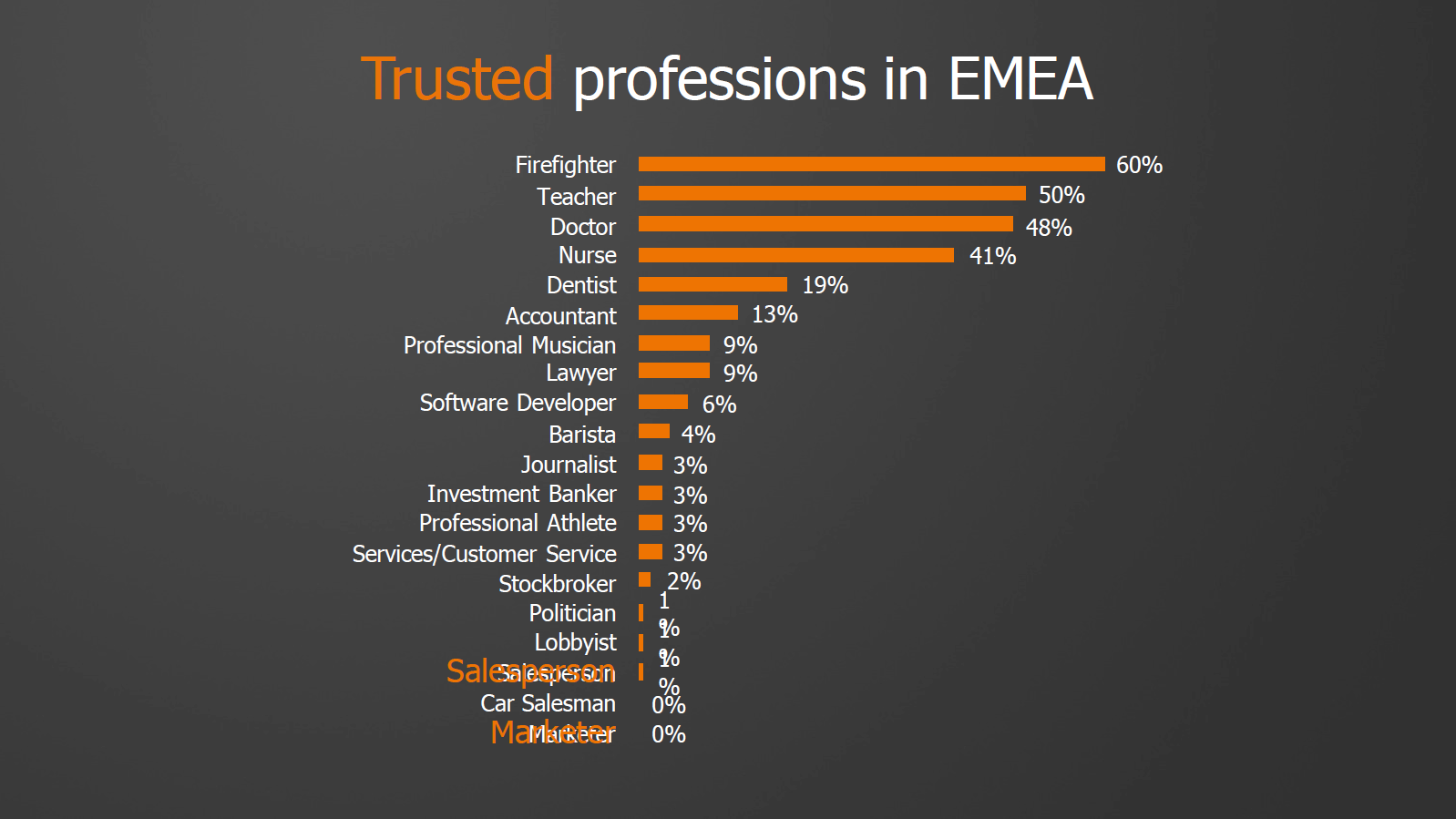
What is the most trusted profession?
Trust Issues: Why Sales and Marketing Need a Makeover
Pop quiz: Who's the most trusted professional in EMEA? Spoiler alert: It's not salespeople or marketers. (Sorry, folks!)
The Trust Leaderboard:
- Firefighters (Heroes in helmets!)
- ...
- ... [A long way down] Baristas (Your $4 latte comes with a side of trust) [Even further down] Marketers and Salespeople (Ouch!)
Why the Trust Deficit?
- Marketers: Masters of the hard sell and spam
- Salespeople: Slightly better, but still behind Boris Johnson (Double ouch!)
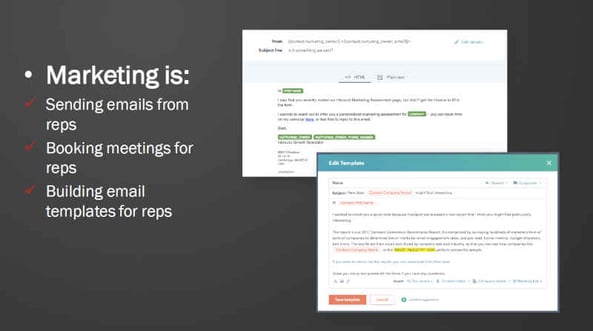
The Hard Truth: In 2018, no trust = no sale
The Smarketing Solution: It's time for a trust transfusion! Enter the era of integrated sales and marketing:
- Marketing's New Role: • Crafting emails for salespeople (Typo-free, we hope!) • Booking meetings (Yes, really!) • Creating proposals (Bye-bye, 12-hour sales pitch marathons)
- The HubSpot Smarketing Machine: "You cannot live unless the HubSpot smarketing machine feeds you like a baby goat" • Nurturing leads • Providing valuable content • Supporting the entire sales process
The Bottom Line: Trust is the new currency in business. By aligning sales and marketing (hello, smarketing!), you can rebuild that trust and create a well-oiled revenue machine.
Remember: In the trust economy, authenticity and value win every time. Are you ready to become a trusted advisor instead of just another salesperson?
Smarketing meetings
We actually have something called the smarketing meeting: Sales and Marketing alignment is a big thing at HubSpot. And then Marketing is building email templates for reps. So that we can study that information so that we can provide it.
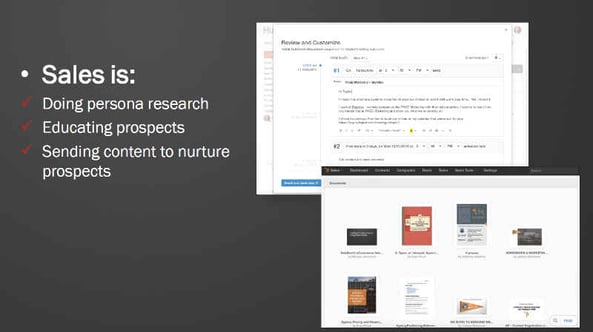
Persona research & demographics
From Demographics to Personas: The Evolution of Sales and Marketing
Welcome to the age of personalization, where one-size-fits-all is so last century. Let's dive into the brave new world of buyer personas and smarketing!
The Great Shift: Demographics → Personas
- Old school: Categories and boxes
- New school: Emotional connections and trust
Why Personas Matter: "Salespeople need to understand the buyer personas."
- It's not just about age and income anymore
- It's about hopes, fears, and motivations
The New Sales Playbook:
- Ditch the qualifying questions
- Embrace "shelping" (selling + helping)
- Educate prospects (just like marketing does)
- Nurture leads with valuable content
2024 Challenge: The Expanding Funnel
- Harder to get (and keep) people's attention
- Solution: Manage a wider, more nuanced funnel
- Secret weapon: Automate the low-value work
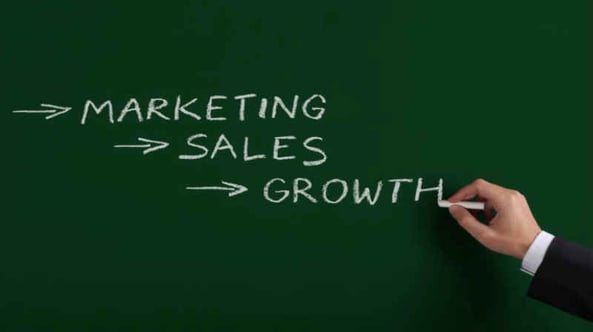
The Smarketing Formula for Success: Marketing + Sales = Growth
The Proof is in the Pudding: "Companies that align Marketing and Sales grow 20% more quickly"
- Backed by Aberdeen, Gartner, and HubSpot research
Why Smarketing Wins:
- Breaks down outdated silos
- Embraces the new buyer's journey
- Puts the customer at the center
The Hard Truth: "Every company wants to grow, but not everybody wants to change" - Todd Hockenberry
Your Mission (Should You Choose to Accept It):
- Invest in understanding buyer personas
- Align sales and marketing efforts
- Embrace the "shelping" mindset
- Automate to focus on high-value activities
Remember: In 2024, growth belongs to those who adapt. Are you ready to evolve?
The Inbound methodology
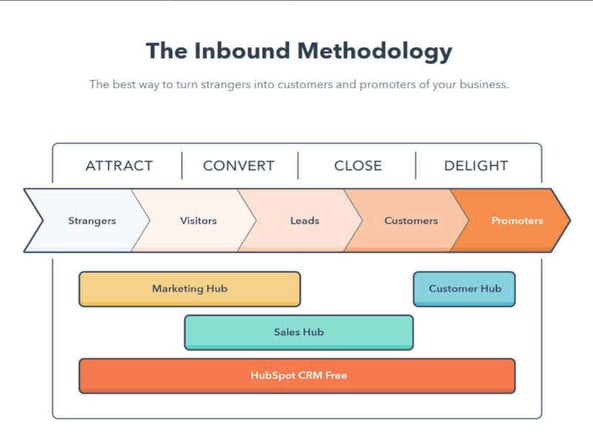
The Inbound Revolution: How Buying Behavior Changed Everything
Remember 2004? When buying meant flipping through magazines and chatting with pushy salespeople? Those days are long gone, folks. Welcome to the Inbound Era!
The Great Shift:
- Then, Salespeople were information gatekeepers
- Now, Google is your shopping assistant
The New Buying Journey:
- Have a need
- Google it (obviously)
- Read 2,375,416 reviews (give or take a few)
- Make a decision
- Maybe talk to a salesperson (if you absolutely must)
The Mind-Blowing Stat: "93% of B2B and B2C searches start online or on social media" (We're still wondering what the other 7% are doing. Carrier pigeons, perhaps?)
Why This Matters:
- Buyers are in control now
- Information is abundant and free
- Trust in reviews > Trust in salespeople
The Self-Service Dream: Q: When do buyers want to talk to salespeople? A: Preferably never. (Sorry, sales folks!)
The New Role of Sales:
- Not just qualifying and closing
- Adding value beyond what Google can provide
- Becoming trusted advisors, not pushy pitchers
The Bottom Line: The internet changed everything. The inbound methodology is about adapting to this new reality, meeting buyers where they are, and providing value at every stage.
Your mission: Embrace the Inbound way, or risk becoming as outdated as a 2004 Yellow Pages ad.
The buyer has all the control
We're going to talk a little bit about that today, but the buyer has all the control: because you have all the information, because all you have access to all this information. The statistics say that:
"People don't really want to talk to a salesperson until they're 65% to 85% of the way through the sales process"
In some industries, it's 99%, in some industries it's all the way to the end, right? They never want to talk to a salesperson. The statistics say that 57%... you say no? No question, no question. So in my book, I talk about buying a half a million dollar laser.
And I talk about the president of this company who walks up to the president of the laser company and says: 'I want an MX 1473'.
And he goes: 'How do you know about that?'
And he goes: 'I did my research online'.
He goes: 'I have three options. You're either going to sell it to me at this price'.
This a half a million dollar laser. This is the president of the company and they haven't announced the product yet.
And he says: 'You're going to sell to me at this price or I'm going to go to the opposition'. Welcome to 2018.
And so salespeople are still important. Salespeople just morph. In the old days we did 95% of the stuff, now we do 20-25%. It's still important. You still establish that relationship. It's still crucial.
"But if Marketing doesn't do their job right, you're not going to close that deal"
Most people want to do 65% to 85% of the research online just like Ian. Because they want to be in control, they want to find everything, and then they want specific things from their salespeople. And I'm going to tell you the specific things that they want.
Some people say: 'Well, that's not really the way it is in my industry'.
And there are some differences. But in most cases, if you don't help leads at the beginning, you're not going to build trust with that customer. And if you don't build trust with that customer, you don't have a shot. So in the old days, you hired a vice president of Sales to go out and charge the hill, today you hire one of the marketing people in this room.
It's a great time to be a marketer
It's a great time to be a marketer, because if you can bring the leads to the yard, that provides a huge competitive advantage. If you can get people, first of all, define you, that's the attract. And to do that is different in 2018.
Talked to Brian, HubSpot partner - stand up again. Or one of these people about pillar pages and topic clusters. How many people are familiar with pillar pages and topic clusters? I'm going to say 30%.
This 'attract' is critically important because... I do a lot of board level work. I talk with CEOs, I talk with board level people.
I go: 'Do you know where you stand against your competitors online?'.
And they're like: 'No'.
I go: 'I do. You want to know where you stand?'
And then like: 'Yes'.
And in the HubSpot product, the marketing product, there's something called the competitors tab - and Brian can show you how to put in your competitors, they're always interested in seeing that and their Alexa rank, how they're doing on social media, their marketing grade.
And then I do: 'Do you know where you stand on certain keyword?'
And they're like: 'No'.
I go: 'Would you like to know that?'
And they're like: 'Yes'. And there's a fiduciary responsibility to get found online.
The importance of being found on Google (SEO & Search Engine Optimisation)
When I'm trying to create a sense of urgency, I will tell a board of directors:
'What happens if people can't find your website and they find somebody else's?'
They're like: 'We don't get the leads".
I go: 'But what happens?'
They're like: 'But we don't get the leads'.
I go: 'Where do the leads go?'
And what am I looking for? What's the answer to that question? Where do the leads go if they don't find you?
Your direct competitor, right? Just let that thinking for a while.
All the CEOs that are new to inbound or like: 'Oh damn, that's not good'. Right? I never met somebody who said: 'No, I don't want to get found for people who are typing in something into Google search that are looking for my stuff'.
There's a fiduciary responsibility. This is 2018, right? We've been doing this for 11 years. You can say: 'That's not the way it works in my industry', but number 1, you'd likely be wrong, and number 2, I can prove it right now.
Salespeople are still critically important, right? But I got all the data. I got all the facts. I got 45,000 bank customers? I have millions of people are practising Inbound.
This is 2018. You don't jump on this bandwagon and if you guys can't convince your senior team to jump on this band, you got a problem!
Attracting new customers
So the first thing you got to do is attract. The way? How many bloggers are here? I'm gonna say half. Okay. Blogging is super easy. For the salespeople in the audience, blogging is just talking, right? If you can talk, you can blog.
Marketers, if you want your salespeople create content, don't ask them to blog, ask them to talk. They liked to talk? And just sit there when recorded on your phone or just write stuff down and everything that they say redundantly to everybody, that talk is a great blog article.
And if you need help and learning how to write blogs - I think in blog articles now, right after 10 years of HubSpot, I think in blog articles, there's a great article called 74 Blog Article Titles, just write that down, or google that, or just send Brian or myself an email and we'll send you the blog article and it just start with the title:
- 'The 3 Things to Remember When You're Buying a Elephant Push toy'
- 'The 5 Things I wish I Knew Before I went on a Gorilla Conservation Tour'
- 'The 4 Things About Whatever'.
And like, once you have the title that it's easy.
"Salespeople have to contribute to the content"
Once you attract people to your website, then those conversions become critically important.
Anybody knows the average conversion of somebody the first time they come to your website? Guess. Who wants Terrick's Ping Pong Ball? Yes ma'am. 2%? Give the ping pong ball back to that lady. That is awesome.
What's your name? Annette Johnson? You are the ping pong ball champion. They ever must be a UK record for that, that is impressive. 2%. So 98% of the people come to your website they need to understand what you do. The most important thing on your website is not a 'Contact us' page.
How many people have a 'Contact us' page on your website? All right? You're all doing it wrong. That's old school.
You need to have a call to action that say 'A 25 or a 20 or a 15 minutes consultation with whatever expertise that you do'. That's the way we do it.
"'Contact Us' is about you, no one wants to contact you. They want you to help them"
And you have to figure out - last time, HubSpot partner stand up again, last time HubSpot partners, come on, come on. These guys will tell you all about calls to action. Thank you very much. They'll tell you how to optimise call to action.
The more people drop their contact information on your website, the more you're building trust. You're a website has got to be your best salesperson. The good news is you don't have to pay them, you have to feed them, they never sleep. Your website has to be the central opportunity for those conversions. Once people drop their contact information, you have an opportunity to nurture the relationship. This says 'Close', but I usually refer to it as 'Starting the relationship'.
"In the old days we closed the deal, then you never see the salesperson after that, today you start a relationship"
And you only start relationships with people you can do a good job.
In the old days, if I screwed up, if I sold somebody that wasn't like a good fit, you'd like call my boss and you complained to him and then he'd call me into the office and he'd say: 'Dan, don't do that again'. And I'm like: 'Oh yeah, I shouldn't have done that'. Walk out and do it again. That's what we did in 1970s-1980s.
Today, what happens if you're an unsatisfied customer, what do you do?
You're on social media. You're like: 'I'm never doing business with that guy again, both personally as well as professionally'. You see in the United States there are all the cell phone companies and all the cable companies, where people are complaining because they're on hold all the time and they're like tie you up for all day.
You can't do that anymore. There's a significant impact. The difference in 2018 to 2016 is the customer experience and you've got to move toward. So you're looking for strangers move to visitors, move to leads, move to customers, move to promoters, that is the Inbound philosophy.
The inbound philosophy
"Inbound works 8 times better than outbound"
We can prove it. This is the way people want to buy. They want you, number 1, to know who you are. Number 2, they want you to know where you are in the sales process. If you've been to the website 37 times, the salesperson needs to know that, the salesperson needs to know what you like and what you don't like, which emails you're opening and what you're not opening, and this is shared between sales and marketing.
That is the smarketing kind of thing.

The reason I spend a little bit of time on this is this should be in your next marketing or sales presentation. This is the future and the future is now. If you're not practising Inbound, you run the risk of alienating your customers.
"Inbound: the foundation is helping people"
I was just in New York, a 500-person presentation, it was a grow with HubSpot kind of thing, and they're like: 'No, no, no, no, no. We don't want to help our customers'.
And I'm like: 'What? I'm the guy who wants to do the most good for the universe'. I go: 'You don't want to help your customers'.
They go: 'No, that's not the way we do it. We want to sell to our customers'. I'm like: 'All right, well, you got two choices:
- you can help them just because it's a good thing to do, or
- you can help them because you want to earn your business,
He goes:'No, that's not what we want to do'. And this is like a kind of interactive presentation, so I got no choice, I didn't want to embarrass them, but I go:
'Audience, how do you feel about that?'
'Booooh' Like 104 guys.
He was like standing up arguing and then he was like sitting down very slowly.
I'm going: 'They're actually doing you a favour, because this is the way everybody feels. This is the way it work's.
How to Align Marketing and Sales
I'm just getting the meat of the slides. I'm going to spend five minutes on this.
3 things that you have to do to have the Sales and Marketing alignment.
Number 1: You have to set sales goals
The first is you have to set goals. The second is you have to have a service level agreement, and the third is you have to negotiate this hand-off.

So the goal setting is: 'What do we want?'. And this a shared kind of thing.
I was talking to Emily, I'm going: 'Emily, do you know the goal of your company? '
And she says: 'Oh, I think so'.
But you need to know the quota of your vice president of Sales or chief revenue officer, and then you need to know the individual quota of all your Salespeople. That is super important.
"Data gives you power"
Number 2: An SLA Service Level Agreement
Tells you how much do we want
How many people in the audience have an SLA? Only about 10%.
This is super important because it will be new to salespeople. Salespeople are usually a little grumpy. Have you noticed that? Salespeople a little grumpy.
It's because they got a target on their back.
If they don't work, if they don't produce, they're fired. So that gives you a little bit of a thick skin, but it also gives you kind of an attitude where you're going to run like crazy, so you want continue your employment.
Number 3: Lead quality and hand-off
And the third thing that you got to figure out as the lead quality and hand-off, how many people are familiar with MQLs? About half.
It's Marketing Qualified Leads.
Everybody know SQLs?
Sales Qualified Leads.
Anybody knows PQLs? Oh, okay lady, you get to keep your ping pong ball.
It's Product Qualified Leads, right? Very, very good. And let's go walk through this.
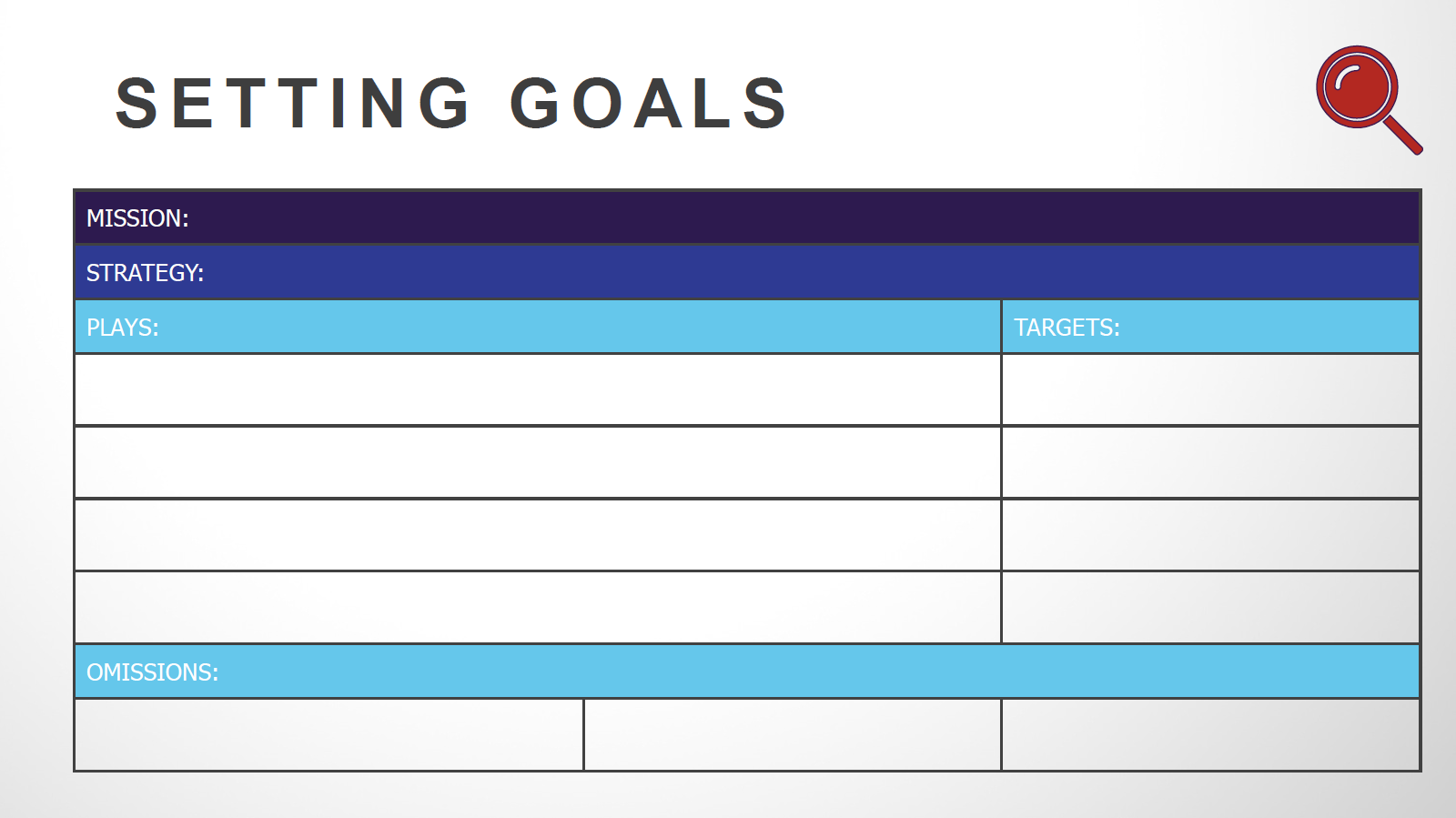
What is an M spot?
The first is... anybody's familiar with an M spot? An M spot is a HubSpot thing, Brian sees it all the time. We wrote about it in the book 'The Inbound Organization'.
An M spot is one page. I'm going to strongly recommend that you build an M spot for either your company (if you're the CEO or for your Sales organisation (if you're in Sales) or for your marketing department.
We start with a company M spot, and moved down to divisional M spots, each one page that shows the mission, the strategy, the plays, the targets, and the omissions. And there's a whole chapter on this in the book about this.
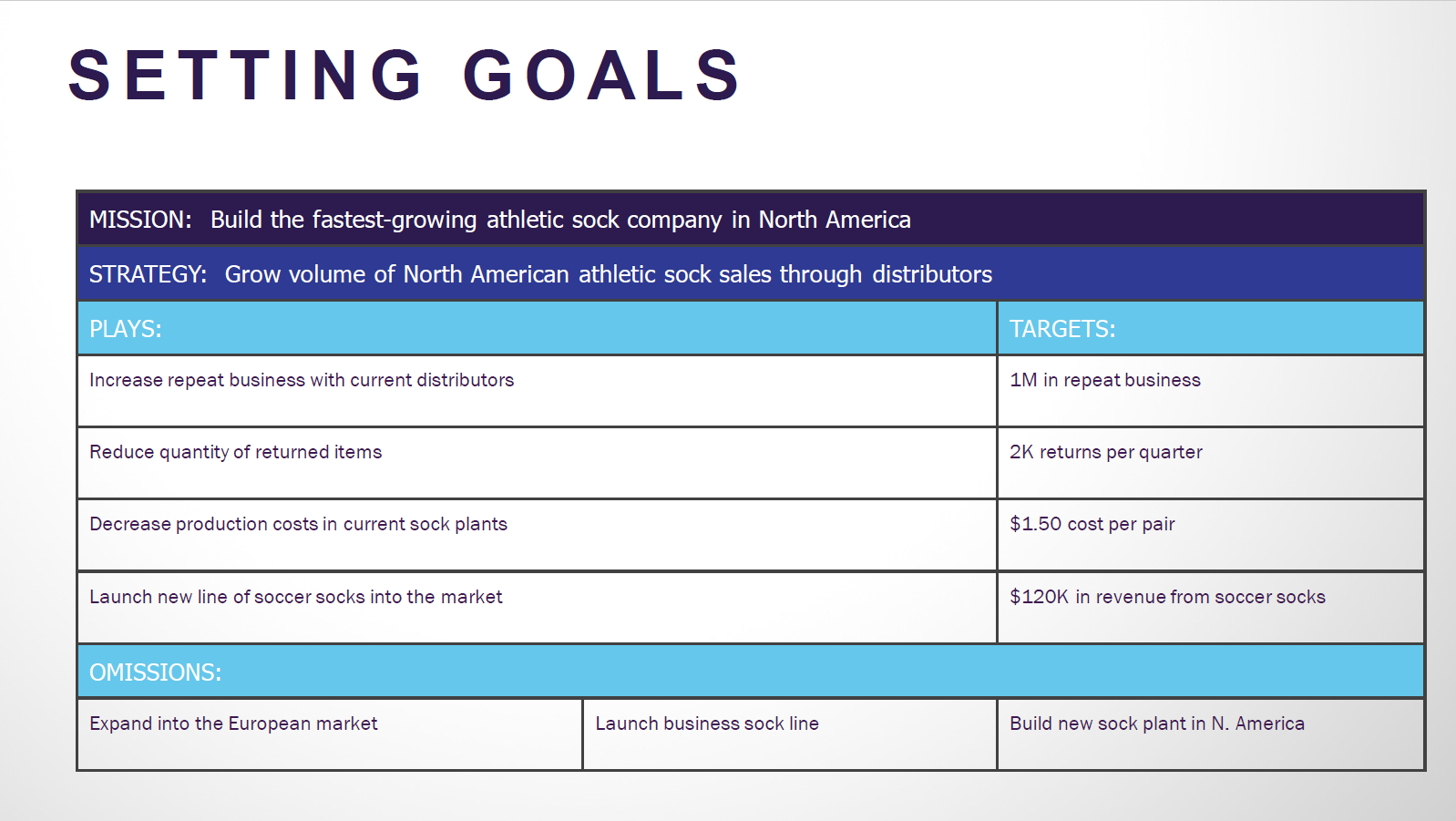
The company mission
As an example, 'build the fastest growing athletic sock company in North America' right there, that's the mission, that's what we want to do. Everybody knows Simon Sinek's 'Finding your why'?
We talk about the importance of understanding what your company mission is in 2018. It's very important to define why you're doing it. It's not good enough to say, well, our mission is to grow. You want to be very, very specific of what your mission is so you can recruit the right people.
Your company strategy
Your strategy is who you're going to service, and how. Your plays are the specific things that you're going to do to get there.
Your targets are how you're going to be measured and your omissions are the things that you've considered that you're not going to do.
The beauty of this is this on one page, the beauty of this is everybody in your organisation should see this and understand, the beauty of this as you can utilise it for Sales and Marketing so there's good interaction between the two, and salespeople and sales executives should know and understand what marketing's goals are and vice versa.
The service level agreement (SLA)
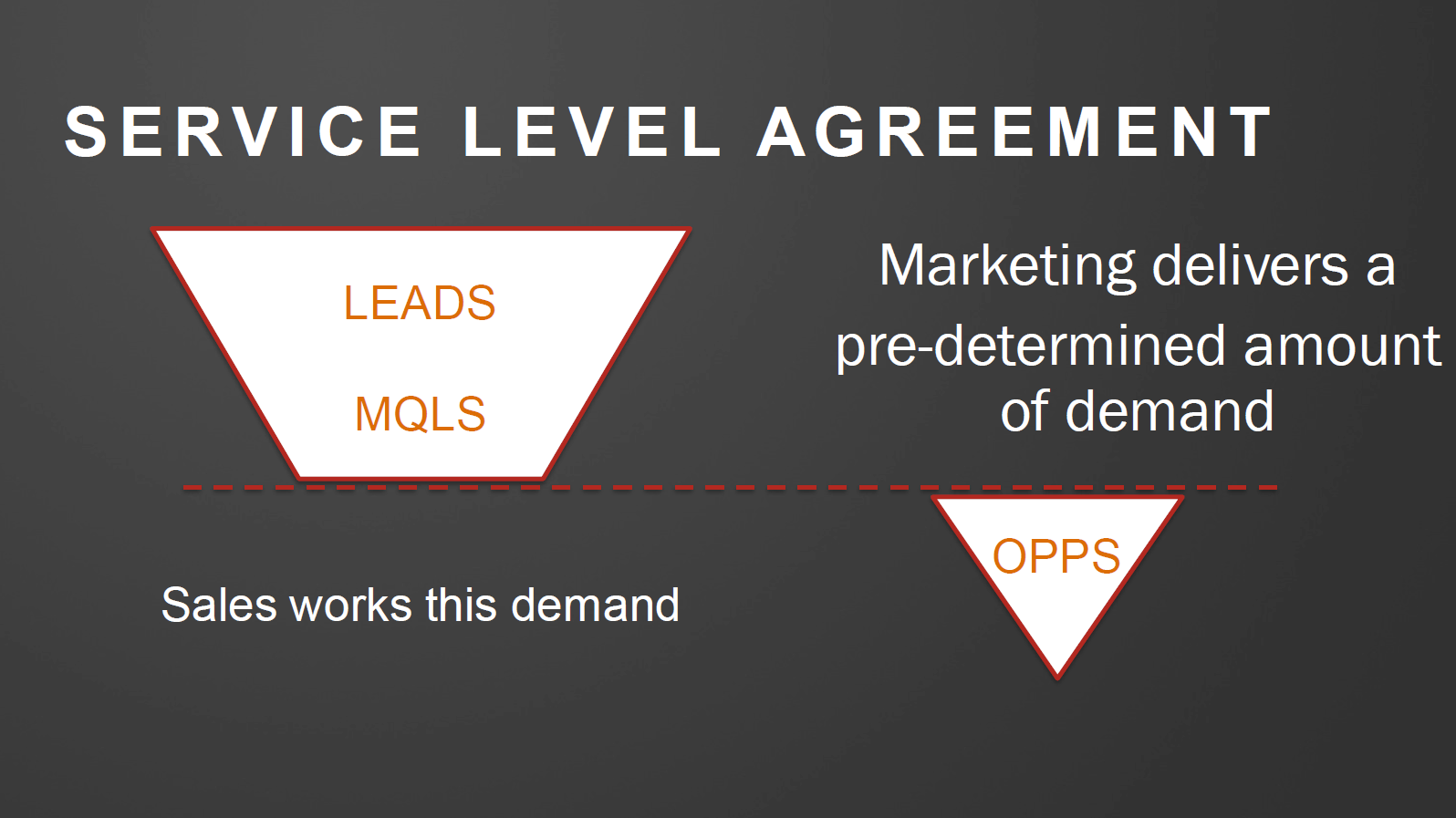
"The Service Level Agreement is what marketing is going to deliver for a pre-determined amount of demand"
That is leads MQLs, SQLs. Everybody wants the more higher quality leads, that takes years to build. The HubSpot marketing agencies can show you how to do it.
But what all the vice president of sales or vice president of sales want are people who are going to buy now. And you can get those, but it's only going to be 1% or 2%, like the lady in the back said, maybe 3% if you're really, really good.
"In 2018 salespeople have to call a prospect 4 times"
And it takes a little bit of time to do it, the bottom part of this is how sales works the demand, and in 2018 salespeople have to call a prospect 4 times. They have to email somebody 4 times. And the third email should be a video email.
Using video in sales and marketing
How many people are using video email? A handful. Okay. What do you use, Soapbox or Vidyard or Loom? So, all of those companies have free products that you can use.
Anybody ever receive a video email? That's it. Yes. So all of those three - Vidyard, Loom and Soapbox - all plays right in the email.
If you have to click a link and it goes to someplace else, you won't do it. Because you don't know if it's coming from Russia or China or wherever. Yes, I know, I know. If you see a little picture and you see Clwyd in the picture right now of a sudden he's smiling, he sold in the little stuffed elephant or something like that and he likes looks human. That is like right out of Harry Potter?
It's amazing? And Pluto is going to say: 'Now I've got 90 seconds. You can't take more than 90 seconds. And what you want to do is you're trying to be human. When you're trying to get that across that much better than a cold call, right? It's like 30 times better than a cold call.
"The conversion for a video email is between 24% and 30%"
Based on the HubSpot research. My bold prediction is you'll be getting three of them a day starting in October, because everybody's going to jump on this bandwagon, it's just too effective not to be there.
But the thing for salespeople is that there's lots of agencies here in London who would create tons of leads, but the salespeople would screw it up. The reason why you have to have the smarketing alignment is if Marketing does all this great stuff to nurture the leads, be human, provide this content through the top of the funnel stuff and then a salesperson calls up and like ruins it. Boom. All that money gone away.
So the salespeople then have to professionally pursue. So when a salesperson has to do is have to call four times, email four times, the third email is a video email: you'll never get me on the first email.
I am backed up 600 emails and it's only 10:30 in the morning. If you send the second email and it says second email, I'm like: 'Oh yeah, that lady sent me an email'.
If it says: 'Ask for my voicemail', I go: 'Yeah. Yeah. That's the lady you left me the voicemail'. I rarely returned my voicemails.
I'll look at them like maybe an October. They're all there, right? I got 156 of them. I'll try to get to them. I got the best intentions, but it's just the way it works.
And your salespeople have to align with that SLA.
"They have to agree to call 4 times or email 4 times or it's not worth it."
What we see is sometimes people will call once/email once and say: 'Oh, the leads suck'. That's not good. You have to professionally pursue in a way that it works.
Those creation of the OPPs, and then you need to study all of the process, in some industries sometimes you have to call six times, sometimes you have to email six times, but the HubSpot research study says that after 4 times and 4 emails - by the way, the fourth email is 'should I stay or should I go?'.
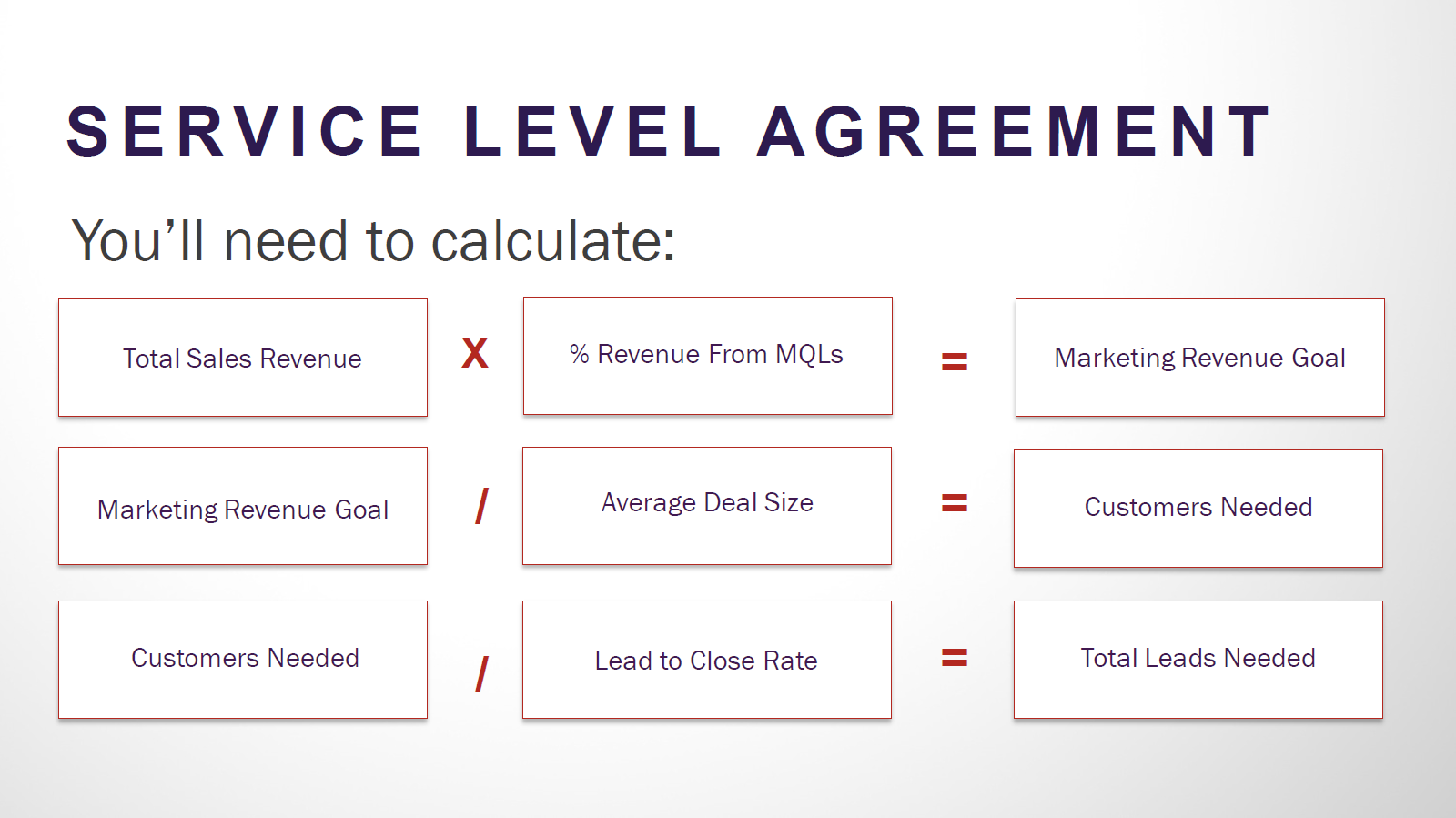
How to calculate your SLA
So you have to calculate your Service Level Agreement. To do that, you figure out what your total goal is. Then, how much new revenue you want to create?
And so you say:
- This is the amount of revenue you want to create
- This is the number of customers you need
"Marketing now has a quota"
Now, what I'm saying is marketing now has a quota. You're going to go to your vice president of sales and say: 'I want some of your quotas'. The guy who's gonna look at you, he's going to say:' Why?'
'I'm going to help you hit your quota'
How much do you want me to take?
Because I will turn SQLs into this revenue and in exchange this is what I need.
- This is the number of customers I need
- This is the approximate close rate
- These are the total leads that I need to create
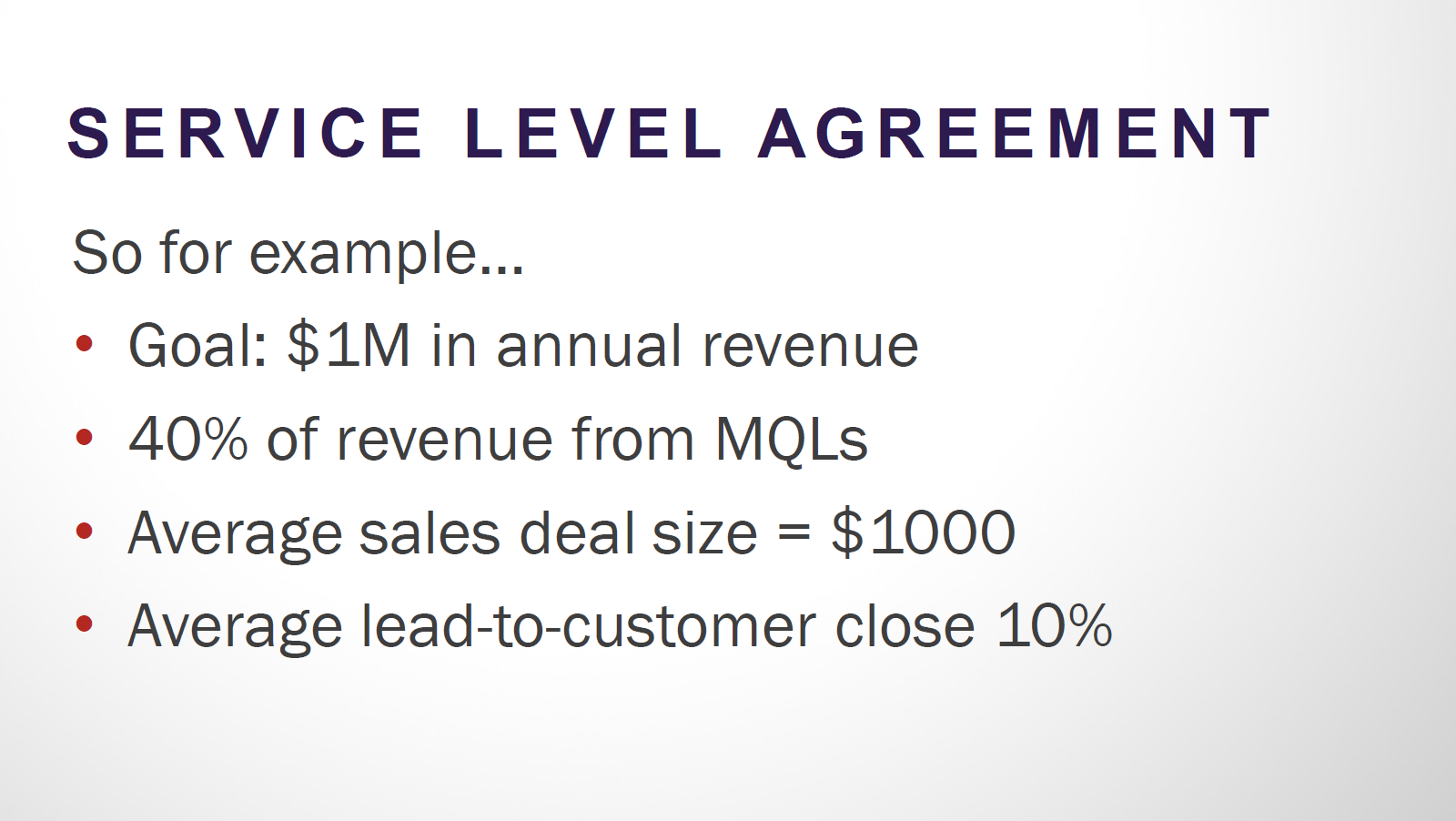
So for an example, if you want a million dollars in annual revenue, you want 40% of that revenue from MQLs; the average deal size is a thousand, the average lead to customer close is 10%.
Now you have the algorithm, now you have the information that you need to go ahead and do it. And then final piece in this segment, we'll come back after Ian's presentation, is the hand-off.
Handing leads over to the sales team
"You have to decide when you're going to give the leads to the salespeople"
In HubSpot world we don't give leads to Brian until they've come back to the website at least three times.
Some people, because they need more leads, will give their salespeople the leads the first time they come to the website and we're okay with that. You just have to be very cordial when you engage, when you pick up the phone, you say: 'This is Dan from HubSpot' or 'This is Pete from Hubspot', or 'This is Clwyd from Whitehat'.
You tell your salespeople if they're calling, I want them to stand up, I want them to smile. I want them to be friendly. I want them to be human. And then they're going to ask 2 important questions.
Number 1: 'How are you doing today?'
They're going to ask, can you do that in the UK? Somebody told me you can't do that. I don't know. Clwyd, what do you think? It depends. All right, you guys... Victoria gave me the frown, so I'm thinking maybe that's a little bit aggressive for this audience.
Number 2: 'Can I ask what were you looking for help with?'
Remember they've come to the website and converting. Is that okay within your... Okay. Everybody's agree with that, so maybe skip the first question and go: 'What were you looking for help with?' Now that's transformation. That is a very human thing. Rarely will people decline that out. You're just following up professionally.
How quickly should I follow up a new lead?
Anybody know how quickly you have to follow up? 10 minutes? What's your name? Ellen. Very good. It's actually 5 minutes to if you don't follow up with them, 5 minutes, the percentage of close decreases by 90%.
That's in the state of Inbound, 2017. It's a Kellogg study. And it is amazing. That's why if you don't have lead notifications, which we'll talk about in the second part, you will never sell anything. That hand-off is important. We talk about 2 things.
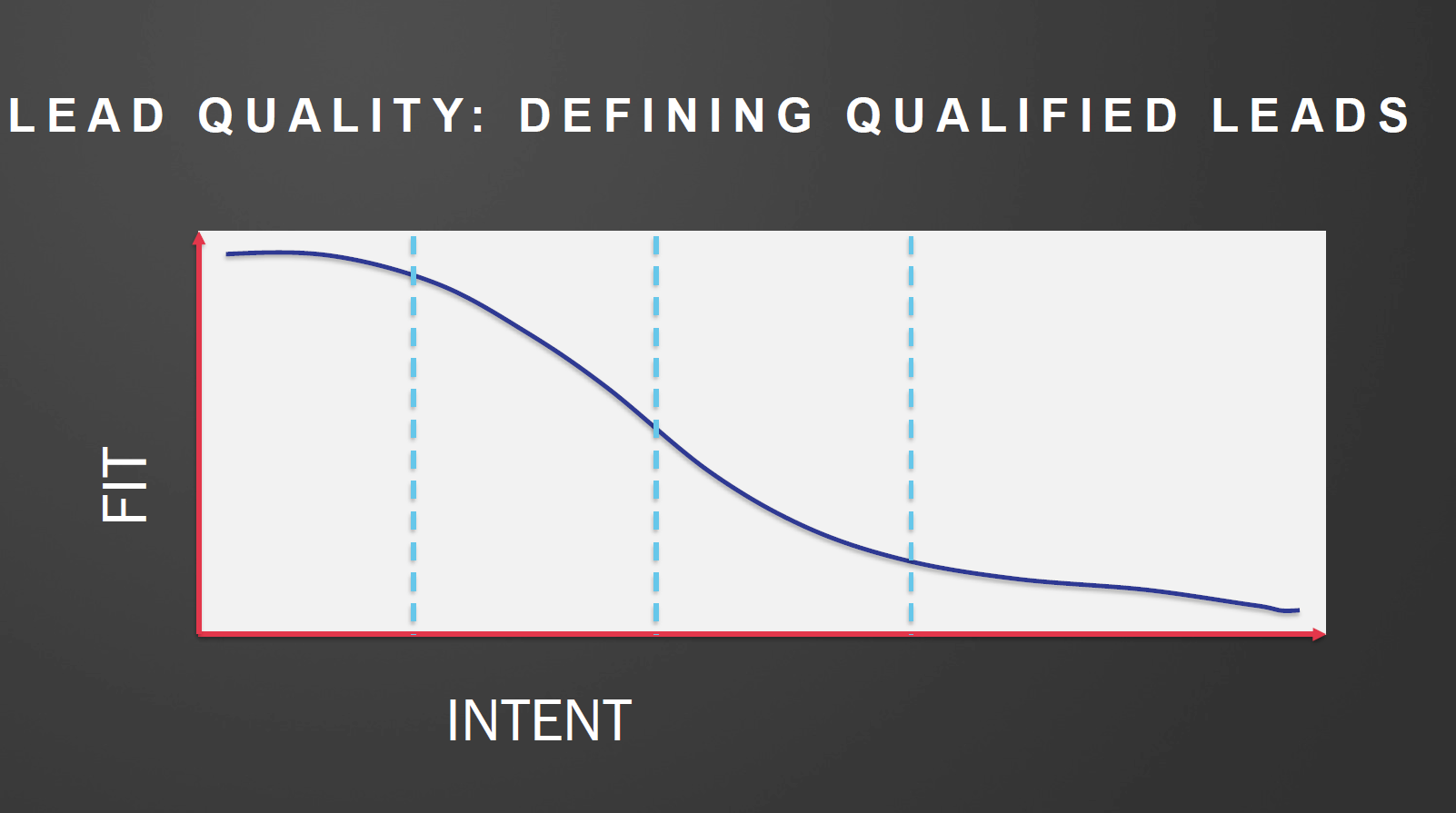
Number 1 is fit, number 2 is intent. Fit is what page they go to. So if you don't know which page people go to, you don't know if he/her is a kind of a good fit customer. And intent is what they mean by that page.
At HubSpot, we grade all of our leads and Brian knows if this is a highly ready to leave or a low ready to leave. For Sales and Marketing alignment, the more information you give to a salesperson, the better.
If you're using the growth stack, our free CRM software will tell salespeople which leads to call first. That is a huge hairball for most folks, because they're so disorganised, they don't know what the priority they should call and the HubSpot software will do that for them.
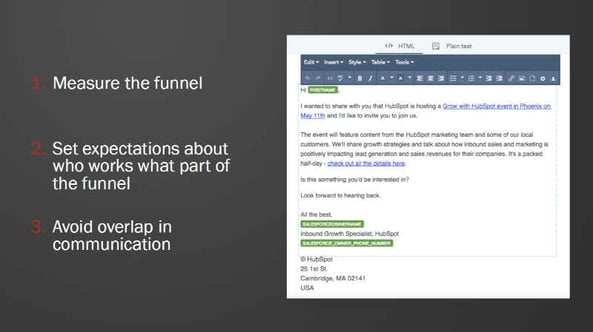
So the thing is to measure the funnel and set expectations about who works and what part.
"Marketing in 2018 is less like pictures and stories and more about data and facts"
What you want to do is avoid overlap in the communication, you want to be very clear in the hand-off, when Marketing owns it and when Sales owns it. When Marketing sends an email for Brian Sexton, it comes from Brian Sexton, even it has his on picture on it, it is great, you will not know that is not Brian Sexton.
If you're doing it on a high level, even when you cycle into the website you'll see a chat-bot and you'll see Brian Sexton's face on, and if Brian face converts a higher percentage that a female face or something like that, then you will use Brian more often.
And if we know the IP address and we know you are covered by a territory that Brian covers, boom! We'll provide the human interaction in that chat-bot. Was that too quick? Was that good? Scale 1 to 10, how did I do? I only did half of my presentation. The jokes on the second half are much much better.
Why Inbound Marketing Is the Future
Marketing part two
I did say they were going to be funny jokes and the second part. You guys ready for some more British humour? No, I can go through these slides.

More Dan Tyre Jokes
How about this one? I don't want to get technical or anything, but according to chemistry, alcohol is a solution. Alcohol, because no great story started something with someone eating a salad.
About that one. Actually there's a funny story with this one. There's a funny story with everyone. I only drank in five foreign countries: I don't drink in United States, I don't drink in the UK. I only drink in five foreign countries. It's a long story. The official sunblock of Ireland. Where's Bryan Sexton? Anybody yet? Brian? I know, I know. Is that funny? Alright. And here's some Clwyd humour for the mathematicians in our thing. I know. I know, I know. Alright.
Always be closing is dead. How to always be helping
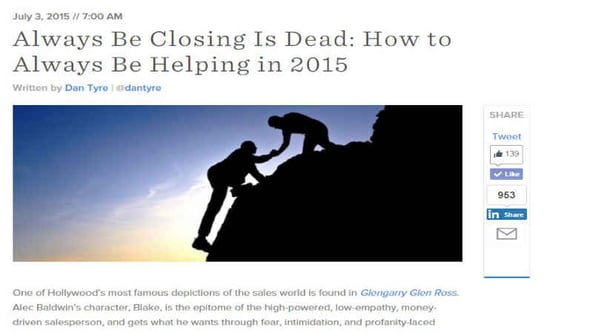
I mentioned I'm a blogger. In 2015 I wrote this blog article, Always Be Closing Is Dead. How to Always Be Helping in 2015. I sold for HubSpot 2 times, first time for 12 months when I first started, second time in 2015. And when I went back into the funnel to directly sign up a customer, I realised there was a huge change in the early days, right?
Monitor the sales process
Sales people, we're in control in 2015. It was very clear that the customer was in control and what I wanted to do is monitor my sales process and improve my sales process. So he's very evident that I would give control to the salespeople. So I would call them up. I would track people down for calls, for emails. We didn't have video email back then, but I would professionally pursue them.
I would pick up the phone, I'd say: 'This is Dan from HubSpot', maybe like: 'What? Who?' Because I speak a little quickly and I'd laugh like cackle: 'Ahahah... this is Dan from HubSpot'. And they would say: 'Oh, HubSpot'.
About half people would understand, half people say: 'Who? what?', and I'd say: 'How are you doing today?' And they'd be: 'Okay, I'm doing okay'. And then I would say: 'What were you looking for help with?' And this whole process of helping people to earn their trust was a very much in the mainstream and is exactly what works today.
The inbound organization
A couple of the comments in the break, some people have difficulties explaining to your senior management that this is the way to go. How many people are in that boat? So that's the reason I wrote the book. The Inbound organisation helps you understand how to convince your senior managers that this is the future.
Everybody wants to grow. Not Everybody wants to change.
"Practising Inbound is a competitive advantage"
I tell CEO's of organisations, if you have more than 10 people in your sales organisation, you go back this afternoon, you can wait till tomorrow if you'd like. You take the 2 least performing reps, you fire them, you take that money, you can give them to marketing. Because if you're not producing content, if you are not optimising your website to bring the leads to the yard, there's no way.
The greatest salesperson in the world cannot overcome that disadvantage. I tell marketers, if you're not practising Inbound Marketing and your senior management doesn't want to, you ask them 2 things. Ellen and I were talking about this.
Number 1: it's not easy
It takes time for them to understand that Inbound is a philosophy. To practice Inbound, you need to be Inbound, and they have to understand that's a option of helping people as a competitive advantage.
Who was telling me about their company? It was Taisy, Taisy was saying: 'No, they want to do what they've done for the last 30 years and they can. That's their prerogative as senior managers'. The problem with that is that it doesn't give you any advantage.
And what everybody in this room is obsessively looking for is either a competitive advantage or what I find is an unfair advantage. Everybody wants an unfair advantage. Inbound to a certain extent provides that.
"If you lean into helping people, we have the proof that you will build trust"
At the very last you'll be on the short list when they make a customer selection. I tell marketers, if your senior managers aren't getting it, quit and go find somebody who is practising Inbound because this is the future.
It's a great time to be a marking agency today
The reason why it's a great time to be a marketer today - or a marketing agency - is because marketing is now scalable.
"Marketing is now scaleable"
You guys know that it's hard to find developers in the UK, right? And developers have these escalating salaries because they write the code once you use it, multiple times.
Today, a good piece of content is just like code right? This blog article is driven over 2,000 HubSpot customers. It's one of the top 70 blog articles on all of the HubSpot blog. And it says: 'Always be helping in 2015'. If you see today, it was updated to 2016, 2017 to that, you'll see it for the next 18 years. Because it still applies. I tell salespeople: 'If you're not getting Inbound, leads quit'.
Because the calling like saying the same thing 100 times a day, it doesn't work in 2018. We have the statistics. If you get Inbound leads, now it's completely different.
Now you're talking to people who are saying: 'Oh yeah, I remember I downloaded that piece of information that's very, very important'. And this is the basis for the marketing approach. It's no longer up to us.
The marketplace has spoken and unless people are going to go back and not use social media or search as the front part, as actually the front 65% to 85% of their sales process, then you have to lean into this.
Talking with senior management about inbound marketing and sales
One other thing in keeping with my vision of trying to do the most good for the universe. Sometimes I'll go talk with your senior management team. I have no problem picking up the phone and doing a Zoom meeting - everybody use Zoom in the audience? Yep. Everybody likes Zoom. Zoom is great. Great audio, great video. They can see me, they can see the gray hair. If I have to put on a tie, just coach me and I'm happy to come like dress like them and explaining over the last 40 years. There's a huge difference in the last 10.
What do you think is the percentage of people ? I'll throw out a t-shirt on this, so concentrate. The percentage of people who are practising Inbound marketing in the UK? 2%. Anybody else? Anybody else? This is like the price is right? You guys have the prices right here? It's up to you, but you can't go over. All right. Anybody else?
Hold on a second, I'm confused... Who said 10%? Alright, give that gentleman a t-shirt. It's actually 12%. They're not all using HubSpot.
"12% of people in the UK practice inbound marketing"
It's not everybody who's using HubSpot. But the whole idea now moving forward is what we call the code funnel. So when I get to the free gifts, I'm giving you all free stuff that you can bring back to your sales organisation, that will distinctly and effectively increase their productivity.
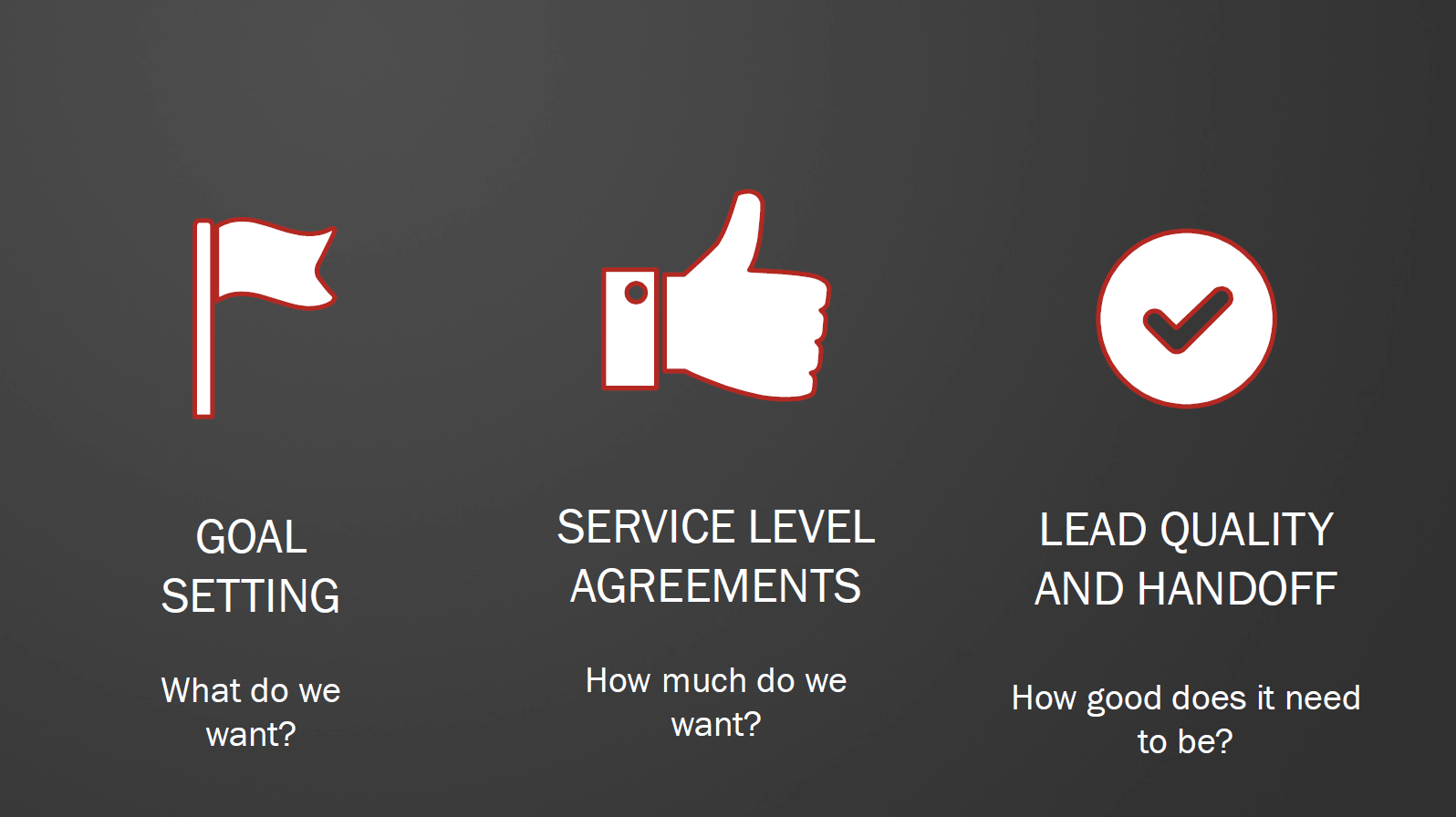
All right, so the 3 things we talked about in the first part of the presentation is goal setting, SLA and Lead Quality and hand-off.
Revenue Goal Setting
Goal setting is important because when you leave this room, I want you to go back to your senior managers, I want you to say: 'What is our goal for generating revenue in 2018?'
Or if we're just finished with the year in the new year, you want to understand where you're going to finish that. You want to understand if you're up down or flat. And then you want to know the goal for next year Everybody should have a goal.
If they don't have a goal, then you create one. And that goal is a revenue goal and it's also a percentage increase goal.
Then you backtrack to understand how many net new customers you need.
There's two ways to get customers
Number 1: Upsell current customers
We call that client engagement. In today's world, all businesses are at risk. Does everybody have good fit customers that they have great relationships with their love? Yeah. Everybody has those.
That is your key competitive advantage against the best transactional companies in the world. The Walmarts, the Amazons, those guys are awesome at transactional kind of stuff.
What smaller businesses are really good at understanding that people, that human kind of stuff, that Inbound kind of stuff, your competitive advantages, creating these personal relationships. So that people will do business with you even you're a little bit more expensive if you can do that, that human type of focus.
Just think if you have three of those great relationships, what would happen if you add 15? That means you can fire some of the marginal customers. That means you can lean into those customers. And so we were talking a little bit with Isabel about how you approach this. With the goal setting, what you want to do is you want to pick a particular niche. So this is very hard for many entrepreneurs.
"The riches are in the niches"
You guys ever heard that? I know. It's a good one, isn't it? I like that.
I know there is a difference in the last two years. It used to be you could sell to everybody. In the first 30 years we sold to everybody, because you could sell to everyone.
In 2018 you can't, unless you're targeted a very specific demographic and persona, right? If you're selling to Clwyd and you want to sell to marketing agencies in London with at least five employees that are focused on life science, that want to grow 50% a year.
When you say that to Clwyd, all of a sudden Clwyd is thinking in his frontal lobes: 'Yeah, that's me' in his brain he's gone: 'Oh my goodness, this is a person who understands who I am!'. And so it's not about you. It's about understanding that niche and that exasperation customer that I had in slide 2 or 3, right to focus on that very small niche.
If you can dominate that niche with a stronger market share, it's easier for you to build that industry knowledge, it's easier for you to share that. It's easier for you to have the common vocabulary.
Identify & connect
So the goal setting has to be very, very specific on the type of companies that you have. In the sales process we call that identify and connect. There are 2 parts to the prospect and we used to call a prospect. The first is identify the right good fit customers, and the second is connect with them effective. So when you do your goal setting, you're going to understand specifically the type of customers you're going to bring on.

Service Level Agreement SLA
And then the SLA. Once again, a SLA is both in Marketing and Sales.
Your marketing folks have to deliver a certain number of leads, a certain number of MQLS, a certain number of SQLS. If you don't know what that is, you start with the number of the revenue, they often increased back into the number of customers, and then you segment.
Typically your SQLs are going to be about 2% of the total lead generation. Your MQLs are going to be 8% to 12 percent and everything else is going to be elite.
And you're responsible for delivering that, either on a monthly and a quarterly basis, and you're judged with dashboards every single day.
You can do it in the HubSpot CRM, you can do it in Salesforce, you can do it in Zoho, just set up the dashboards so you understand where you are against your lead goal.
"The harder part is getting to get salespeople to follow up and to ensure that they're calling in the right metrics."
Salespeople definitely experienced and having a quota. They all understand that they have to hit their quota. They're less excited about calling a lead four times because they'll say what you said: 'I've already called that lead'.
Sometimes they don't know what to say or they're not having the right approach. So when I call somebody and they're saying: 'I'm just calling for educational information, I downloaded the eBook but I haven't read it yet. I'm just early in the process'.
I go: 'Great. My name is Dan, I'm here to help'.
- What can I do to help?
- Can I explain to you what's in the ebook?
- Can I show you a little video?
- Do you want follow up information?
And when you're ready to move to the next step, I'm ready to be there. You have complete control. That freaks them out. They're like: 'What do you mean I have complete control?' I go: 'I am interested in only helping you when you're ready to help, I want to rise like a genie from the keyboard. Exactly when you're ready to go. And I don't want to bother you other than that because you're busy with life'.
So to do that you need a little cooperation, and the cooperation... what you're going to bring to the Sales organisation is a couple of things. First of all, everybody needs what we call lead intelligence.
"Everybody needs lead intelligence"
Lead Intelligence
Anybody know lead intelligence in the audience? Okay, very good. What's lead intelligence? That's very good. That's their buyer persona. We drill that all the way down to the individual, so I need to know is it Tanya? Wow. Yeah, I remember the Arkansas thing. I don't know how I got Tanya in my brain, but Adrian, very good.
You have to bring that down to the individual person. I need to know that you're from Arkansas and have been in London for 15 years. I need to know that you've come back to the website five times. You're a nice person and you might not be overt, but if I know you've come back to the website 47 times, looked at these things, avoided these things, open these emails, watch this video, but just for the first 30 seconds, now I'm empowered.
I can say: 'Adrian, I see that you opened this email. I see you ignore this email. It seems like you're at this part of the process and I can immediately tailor my approach to exactly what you want'.
That is huge because that's exactly what you want. If I don't have that right, I'm at a huge disadvantage. Only 2% of people in UK have that lead intelligence on all the leads.
If you're using the HubSpot free CRM in the UK, you got it, it goes right into the content. You don't have to do anything. You have all of that lead intelligence. If you're using Salesforce, many times you can get that if you're using the HubSpot marketing software as well, but let lead intelligence changes everything.
"lead intelligence changes everything"
Lead notifications
The second thing is the lead notifications. How many people know lead notifications? Okay, so lead notifications. Great, because no one answers their phone anymore, I'm sure you've seen that.
Although the voicemails that pop up, there is only one time when you'll answer the phone and that is if you're on my website looking at the pricing page and the phone rings and you're like: 'Oh my God!' That's not too creepy is it.
Then people say, well, it's a little creepy. I know, I know you gotta like work a little bit, but I'm telling you it's a funny line. And people is like: 'Yes, it is a little creepy, but I'm on your pricing page and I have this question'.
Those lead notifications, I think we were talking about when people open their emails or when they're back on the website. If you don't have that information, how are you going to sell? I don't want to talk to you, Victoria, unless you're interested in talking to me because all I'll do is annoy you.
But if you're like talking and on my website and looking at a blog article, I need to know that you're looking at that blog article. I need to know what the blog article is all about and I need to call you within 5 minutes.
"If you don't have lead notifications, you cannot sell in 2018"
You can. It's just like putting duct tape over your mouth. It is really, really hard.
The HubSpot meeting tool
The 3rd thing is the meetings tool, and anybody use the meetings tool here? Okay. So if you don't use the meetings tool, the meeting tool alleviates the juvenile process of sending an email around saying:
- 'Can you meet on Tuesday?
- Can you meet on Thursday?
- Can you meet on Friday morning?'
- 'No, I'm out that day'.
You feel like you're in high school. The meeting's tool. I sent it to you and it allows you to pick the time that I'm available. It'll only show my available times. If you have multiple people, you can only show the available time for multiple people.
Number 1: The customer gets to decide
The customer gets the cycle in. You're giving the customer control There's a couple of great benefits to that. Anybody see the benefit of giving the customer the ability to set the time they want to meet with you? Shout it out, earn a t-shirt.
What's the benefit of something like a meeting the customer gets complete control? You think they'll blow out that meeting and they set the meeting if they ever blow out that meeting?
Like: 'Oh my God, I set that meeting with that lady that I didn't show up, that's horrible!'
- Number 2, you're giving them control
- Number 3, the efficiency
- Number 4, in the meeting still they see a picture of you
I'm all about the humanness. I don't want her to think of Dan, the salesperson or executive. I want them to think Dan, the human being. It's kind of what Ian was saying, and you should have a little gorilla on your meetings tool. And the ability to start that conversation, of being helpful by not having to do old kind of stuff is super important. That's the teamwork kind of stuff.
How to Do Marketing and Sales Alignment in 2018
So now I want to talk about the process, because we know it's hard of getting your Sales team - or sometimes your marketing team locked in. And it starts with buy-in, communication and enablement.
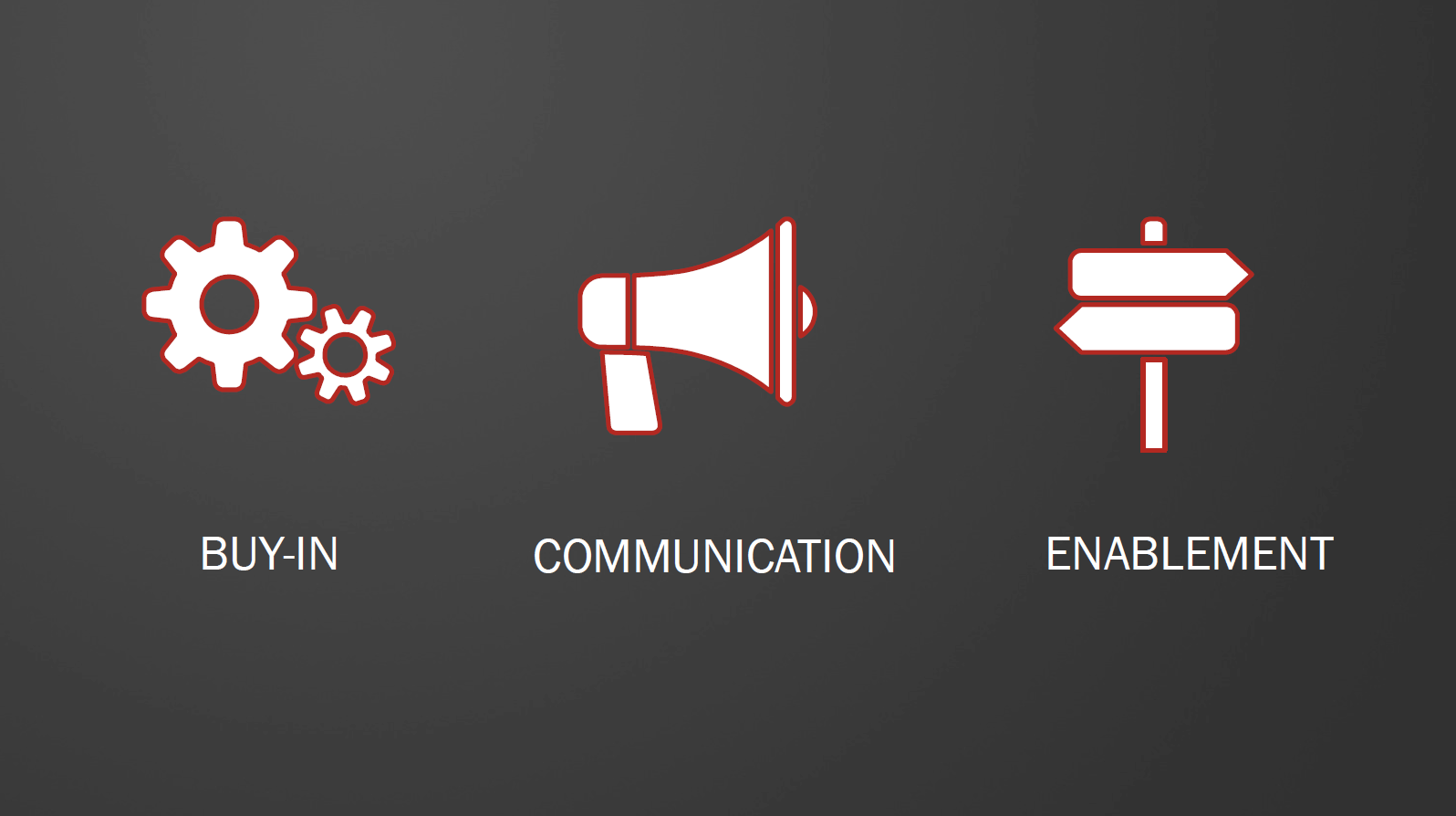
And how many people will think it will be hard for you to get your Sales team to practice marketing? So it is.
Most of you guys are well on your way of doing it. Some people think it's hard. So just that you understand, this is the graphic I was saying, there's still a difference in communication.
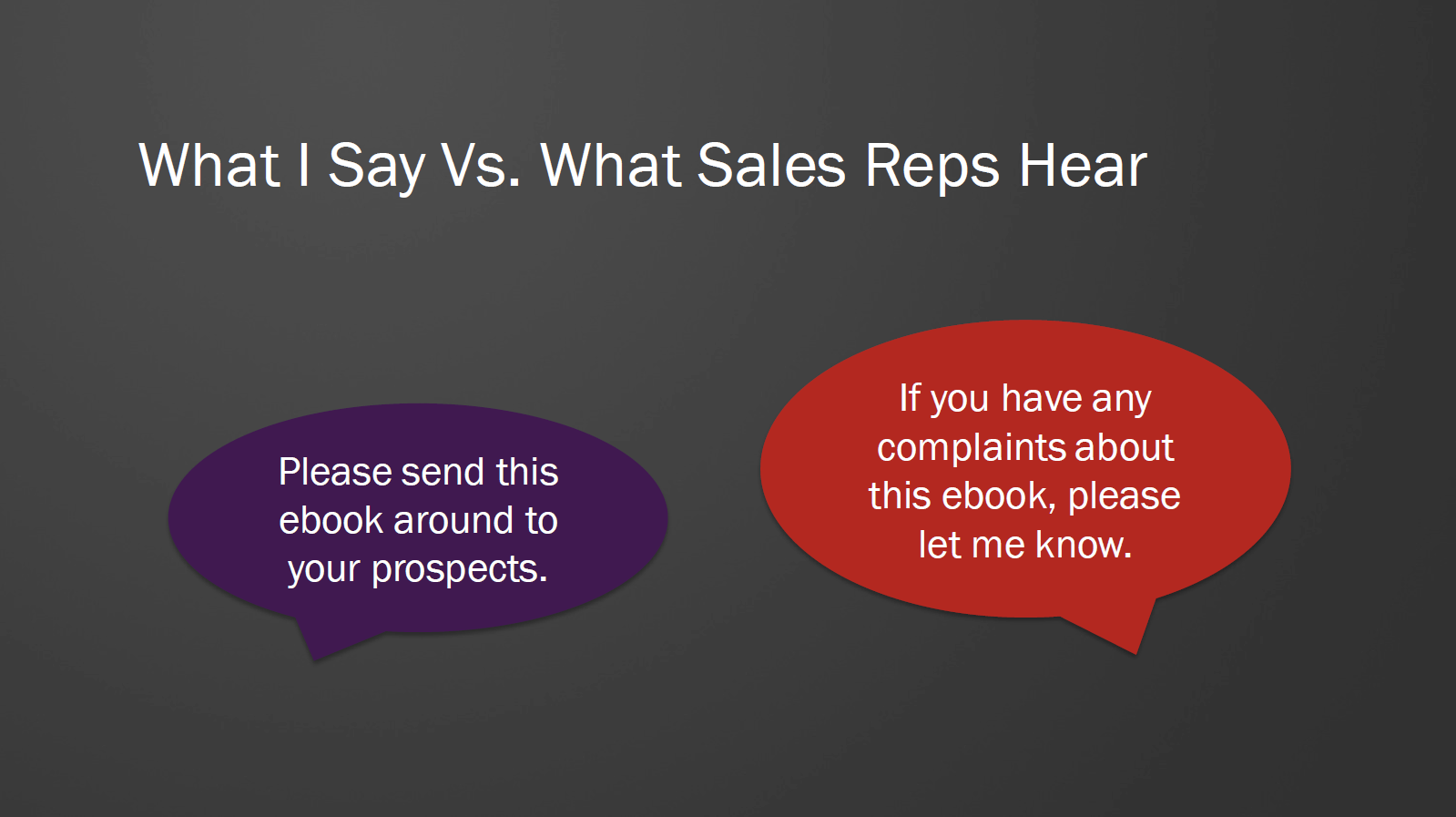
So when you say: 'Please send this eBook around to your prospects', what are your salespeople think? 'If you have any complaints about this eBook, please let me know'.
That's what they're hearing. I know, I know. Edwin, you're like a typical marketer. So you understand what that means.
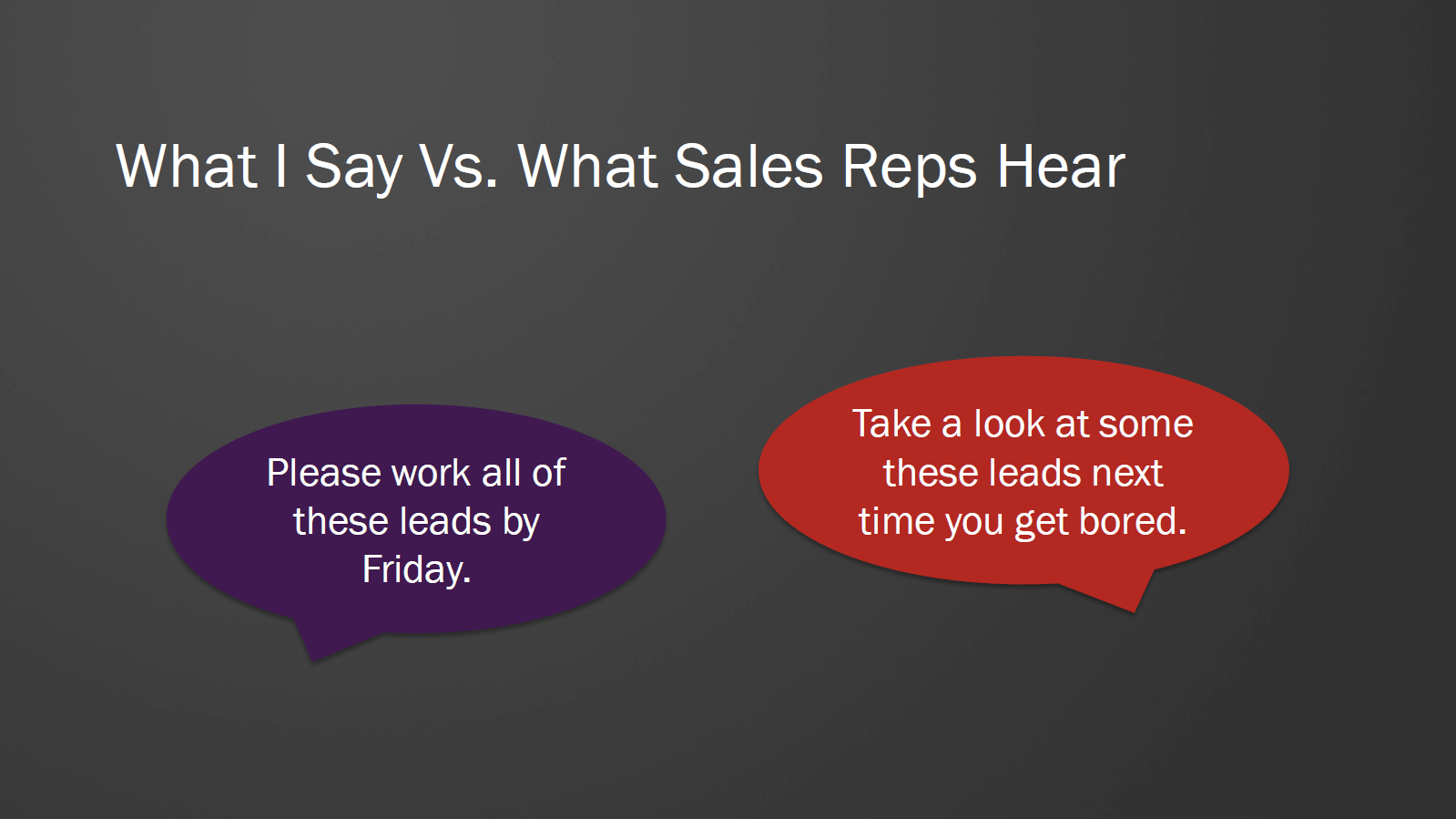
Number 1, 'Please work all your leads by Friday'. They're like: 'All right, take a look at some of these leads next time I get bored'. That's what they're thinking right there. Just in a different plane. Venus and Mars.
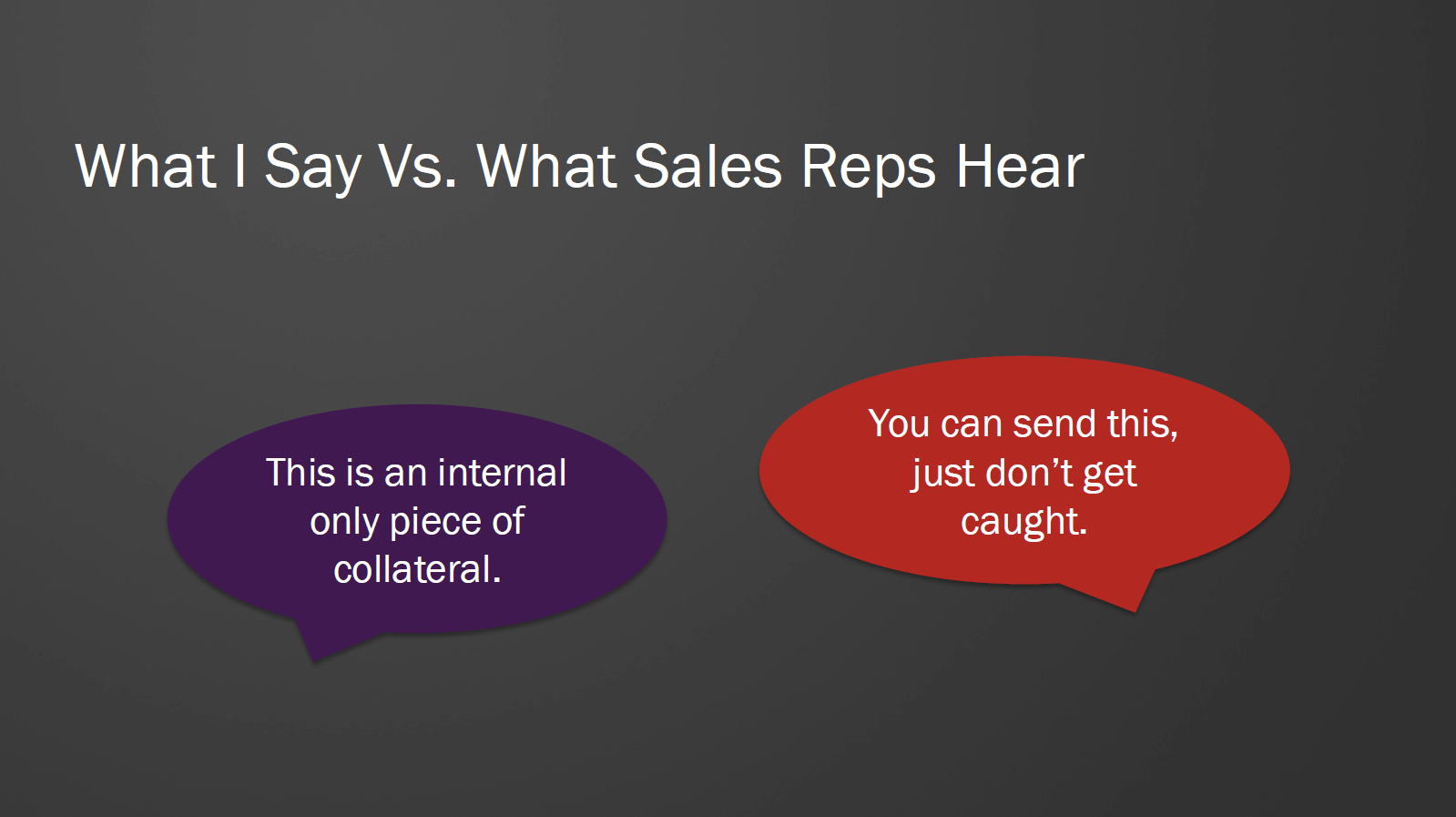
'This is an internal only piece of collateral'. What does that mean? 'You can send it. Just don't get caught'. Exactly. I know, I know. They're just coming from a different thing.
How to get marketing buy-in
So you need to get what we call marketing buy-in. That is at the individual rep level.
"They need to understand that your job is to help them close more deals"
"Your job is to understand what their quota is"
How many deals they have to close either every month or every quarter or every year, and that you own a piece of that.
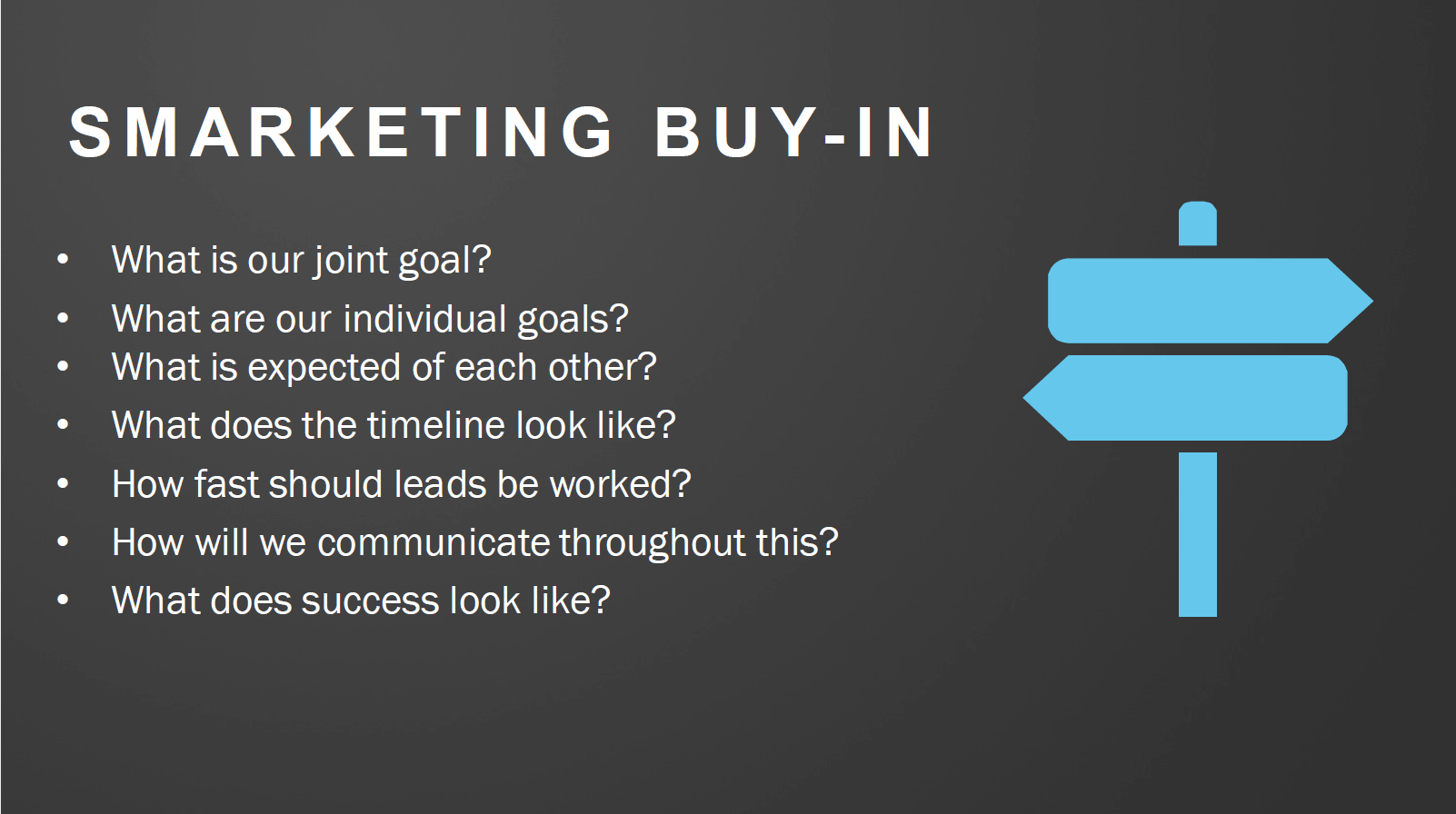
Smarketing Buy-In
So it goes with the organisational goals to start. And then the individual goals, every salesperson in this room should carry a quota. If they don't carry a quota, it's really hard to forecast most organisations.
They need to understand what you expect of them and vice versa: if you're delivering them leads, then you need a little help. There's a couple of ways that they can help.
Sales people can help you create content
They can just sit there and talk that content. The things that they say all the time is annoying to them and it's very helpful for you because that's your next five or 10 or 20 blog articles.
They need to understand that the new way of selling is the followup that I've talked about only helping. What that means for a sales person is that you have to manage a wire funnel, because the customer or prospect is now in control.
It used to be: 'We could push them through this actual funnel'. And now it's not a funnel anymore. It's like a hairball.
Guys know what a hairball is? We have any cat people here. How do you describe Edwin? How do you describe a hairball? Yeah, it's like a ball of hair. It's like all twisted and it's kind of stuff. And what happens? I know I couldn't find a English like alternative. So I went with the hairball thing. It worked. Alright, you guys got it?
People start and stop, start and stop, start and stop. Why do they do that in 2018? It's much different. Part of it is the attention span, but part of its session is the way our life is.
Your boss walks in and says: 'Get this done!' Walks in seven minutes later, he said: 'Forget about that, get this done!' And you're like: 'What? I just talked to this guy, Edward, I just was asking about demand generation'. And that's the way the whole world works.
So they're super interested for five minutes and then they move on. That's why:
"When they're on the website, you have 5 minutes to call"
Because they're thinking about that. They're thinking about it right now and in 7 minutes that are going to move onto the next thing. If you can call them and say: 'I am your resource, I am the person to help'.
Active listening skills for salespeople
Does anybody know the single most important attribute in a salesperson in 2018? guess? Yes ma'am. Empathy is in the top four. Very good. It's not number one.
Who said listening skills? And when you've already won like half the swag we got. So what's your name? Do you want a t-shirt? Okay. Clwyd. Listening skills.
How do you know that? Are you an introvert? Introverts typically make better salespeople in 2018 because of what we call active listening skills. And the number one thing, it's amazing, isn't it? How much does it cost to listen? How much product knowledge do you need to have to listen.
What are the deep training programs that you need to go through so that you can listen? And listening is hard for me, I have to press the mute button all the time. I got a little lion that I squeezed all the time because I didn't want sentence seconds. I didn't want to fill, I just like to talk.
So I pushed the mute button all the time. It doesn't say 'mute' anymore, just says 'm'. I like push it so often.
But listening is super important, because if I'm talking all the time, I don't have an opportunity to figure out what you want. It used to be that you would connect and qualify on the connect call. I would ask:
- "Are you going to buy in the next 30 days?
- And who besides yourself is the decision maker?
- And tell me where you are in the process now',
I just call and say: 'What can I do to help?' And the next stage: 'If you're interested in kind of moving through, used to be a product demo today'. It's a discovery call.
The discovery call
How many people practice a discovery call? Is the second part of the process.
"The discovery call is all about them asking questions about what they need and then practising active listening"
If you want to greatly increase your closing skills, you have to teach your sales organisation how to listen.
There's lots of HubSpot active listening blog articles that we're happy to afford to you because it's a real skill. It's
- Not talking. That's either easier or harder depending on who you are
- Recapping what people are saying
- Explaining and listening, like regurgitating back to them what they have told you.
So you want to understand in the marketing, by and between sales and marketing, what is expected of each person. You want to understand what the timeline is about.
When I say call four times, I don't mean in four hours.
- You call or email, then you wait 48 hours
- You call or email again, then you wait a 48 or 36 hours
- Then, the last time, you wait another 48 hours
"So that's 4 attempts in 10 or 12 days"
Depending on if there is a weekend. And that is the professional outreach that your salespeople have to have, and you have to explain it to them. We no longer use scripts.
When I started my sales career, we started with scripts. Now you have sales playbooks.
A sales playbook
"A Playbook is a description of the persona, a description of what they want and it's a description of how a typical conversation would go"
No salesperson wants to be told exactly what to do. They want to be given a kind of idea of how they would use their own individuality and personality to get that point across. So what the timeline look like, how fast lead should be worked.
Sales Qualified Leads (SQL)
Do you know the SQL (Sales Qualified Leads)? They have to be called within 5 minutes within HubSpot. Sometimes people will call 10 times that first day, but there'll only leave one voicemail.
They'll call within 5 minutes, but they'll continue to track, because SQL is when they say 'Do you want a sales consultation?' That is a very strong call to action.
That means somebody wants to talk with somebody in the closing sequence, and those have a very high closing rate for a HubSpot. And how will we communicate between sales and marketing throughout this?
Typically, if it's done, the information is automatically going into the CRM and you're using the same code stream. It's very, very valuable.
Salespeople are typically horrible at the inputting information. They have the best of intentions, right? But they get busy.
Every sales person wants to improve their productivity. To do that, you need a modern CRM that:
- Automatically logs the call
- Automatically has the lead intelligence
- Automatically has the ability to set meetings
- Automatically has lead notifications
If you don't have that, you're at a competitive disadvantage. And then you have to decide what success looks like.
In most cases, success means meeting your quota, on an individual level as well as a company level. Alright, any questions on this smarketing buy-in?
Sometimes when you're starting to migrate your Sales and Marketing alignment to show Marketing, you'll pick three salespeople. If it's really hard, pick the three millennial salespeople that you have the best shot of explaining this to.
We do top down and bottom up, but we always pick three people to start and if they're the right type of people who are willing to lean into the technology and learn this stuff, they'll usually outperform legacy salesperson.
Internal Communication: How to Apply the Inbound Perspective to Your Company
The second thing is communication.
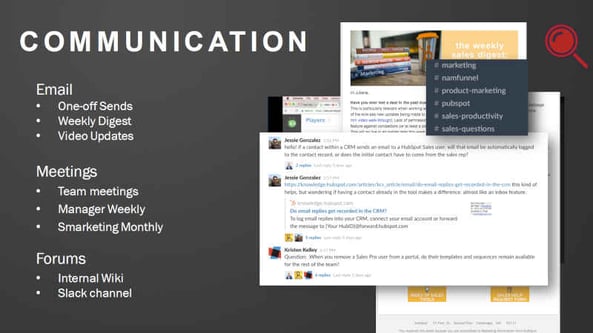
My friend JB Nicholson helped me with this slide. She's responsible for marketing communications at HubSpot. She sends out emails there, sometimes one-off sends. She also sends a weekly digest and she sends video updates.
That's what they look like. That's internal communications for HubSpot. That is awesome. It looks like it's external communications.
"HubSpot spend as much time on the internal communications as we do on the external communications"
Smarketing meetings
Then we hold smarketing meetings, all Sales and Marketing come together on a regular basis because you have to create that situation where people can speak openly about what's happening, what is it, then the managers meet on a weekly basis to discuss whether we're ahead or behind plan and then there's team meetings where we discuss the specific tactics of how we're going to accomplish that.
How many people are familiar with a Wiki? How many people have a Wiki? So about 30%. Wiki is very important because we post all of our statistics all company wide.
"Part of being Inbound a is total transparency"
If our marketing department is behind, first of all, everybody knows about it, but second of all we're very kind of overt about trying to fix that. And so we have a Slack channel and an internal Wiki as a way of making sure that there's immediate communication so that people can work through that.
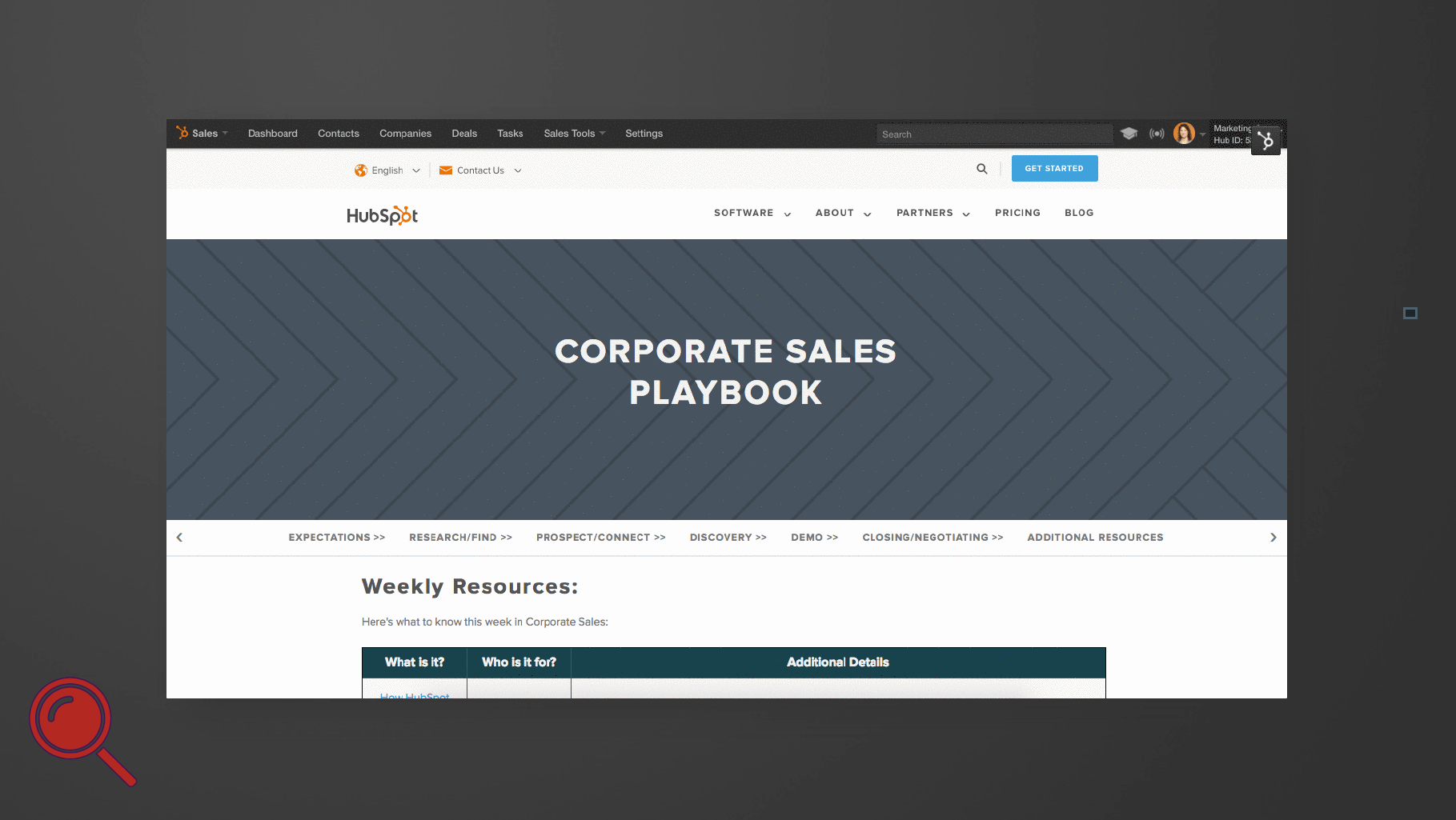
This is a build slide that JB put together. This is a corporate Sales playbook. This is what the marketing organisation that HubSpot uses to enable salespeople have what they're supposed to do.
This is available to everyone that has key resources.
- It has views within the CRM
- It has a prospecting playbooks
- It has an outline
- It has all of the information
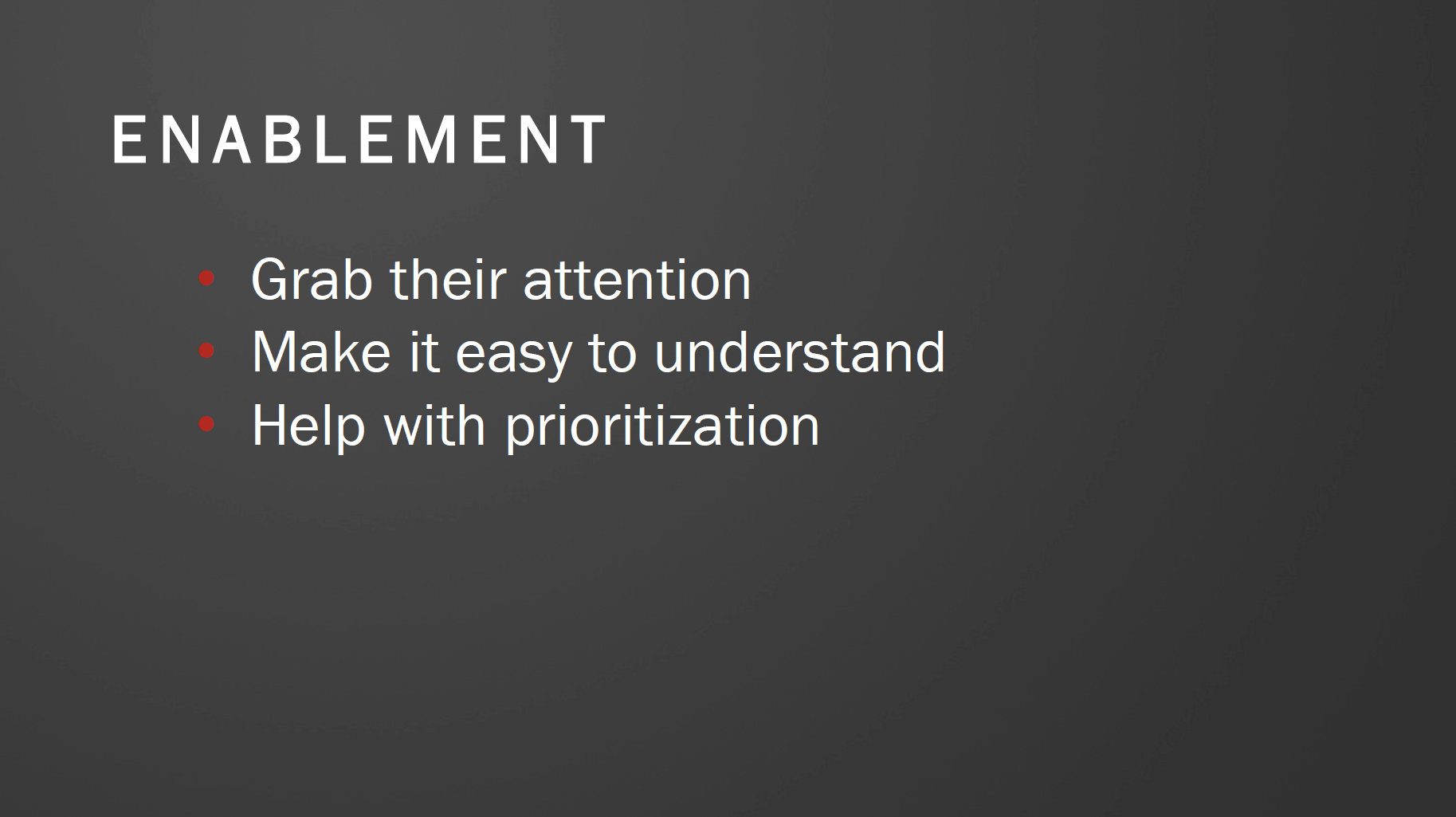
Sales enablement
And then finally around sales enablement. All right, you want to do 3 things. Number 1, grab their attention. Salespeople are not process oriented. They're very ad-hoc. Attention Span. There is like 2 or 3 seconds. And so they're off on their own, they're agreeing to something and then they're gone. So getting their attention is important.
Then making it easy to understand. You gotta feed them like a baby goat, and it's not that they're stupid, it's just they're thinking a lot of stuff. They're trying to do a lot of different things, so the easier make it better. And then you help them with prioritisation. You tell them this is super important.
Show respect for the prospect and use Humour
I think you have to be very respectful and I try to be humorous. Which is, I can tell in the first 20 seconds if somebody isn't interested in communicating and I will say: "Aug! It doesn't sound like you're expecting my call'.
But you're always going to be human. And you're there to help. Most human beings when you say 'I'm here to help' are going to elicit a response with: 'Okay'. And some people don't want help. You're like: 'Okay, I'm going to send you an email if you ever need my help, let me know'.
The only shot you have, though, is helping them when they're ready to be helped. That's why lead notifications are so important.
The first time you have that conversation, if you don't know their background, sometimes if it spends years when we were talking about banking software, some of these sales cycles are three years, they need you to know what they did in 2016.
Because if you go down the same road that they did two years ago, they're ticked off and it's your fault. You have to know that kind of stuff. That's just why it's harder to do it in 2018 and then it'll be super interesting to see another competitive advantage if you have that information. It is.
There'll be this huge differentiation between people who are doing it the old way, which is calling ad-hoc, saying the same thing to everybody else in essentially a one size fits all. It just doesn't work in 2018.
The Growth Playbook For Your Company
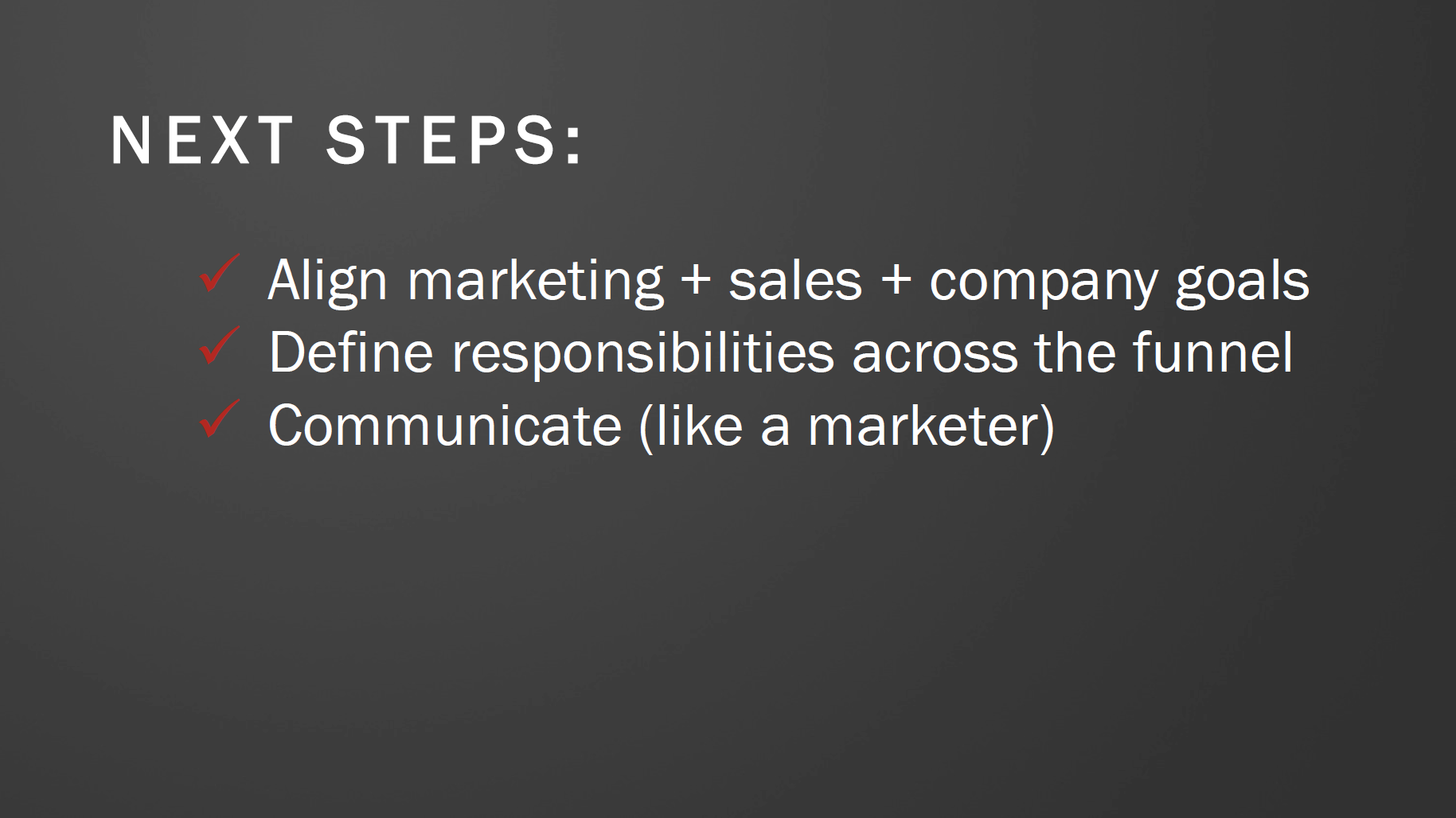
All right, so your next steps when you go back today or tomorrow, align Sales and Marketing and the company goals.
"Marketers need to know what your company goals are and what your amount of quota you're going to take"
You have to define responsibilities across the funnel. So this is what we're going to do.
- This is how many leads, MQL, SQLS we're going to create
- This is how many times you were going to call that will create
- this number of conversations
- this number of opportunities
- this number of proposals and
- this number of customers that will create
- this amount of revenue.
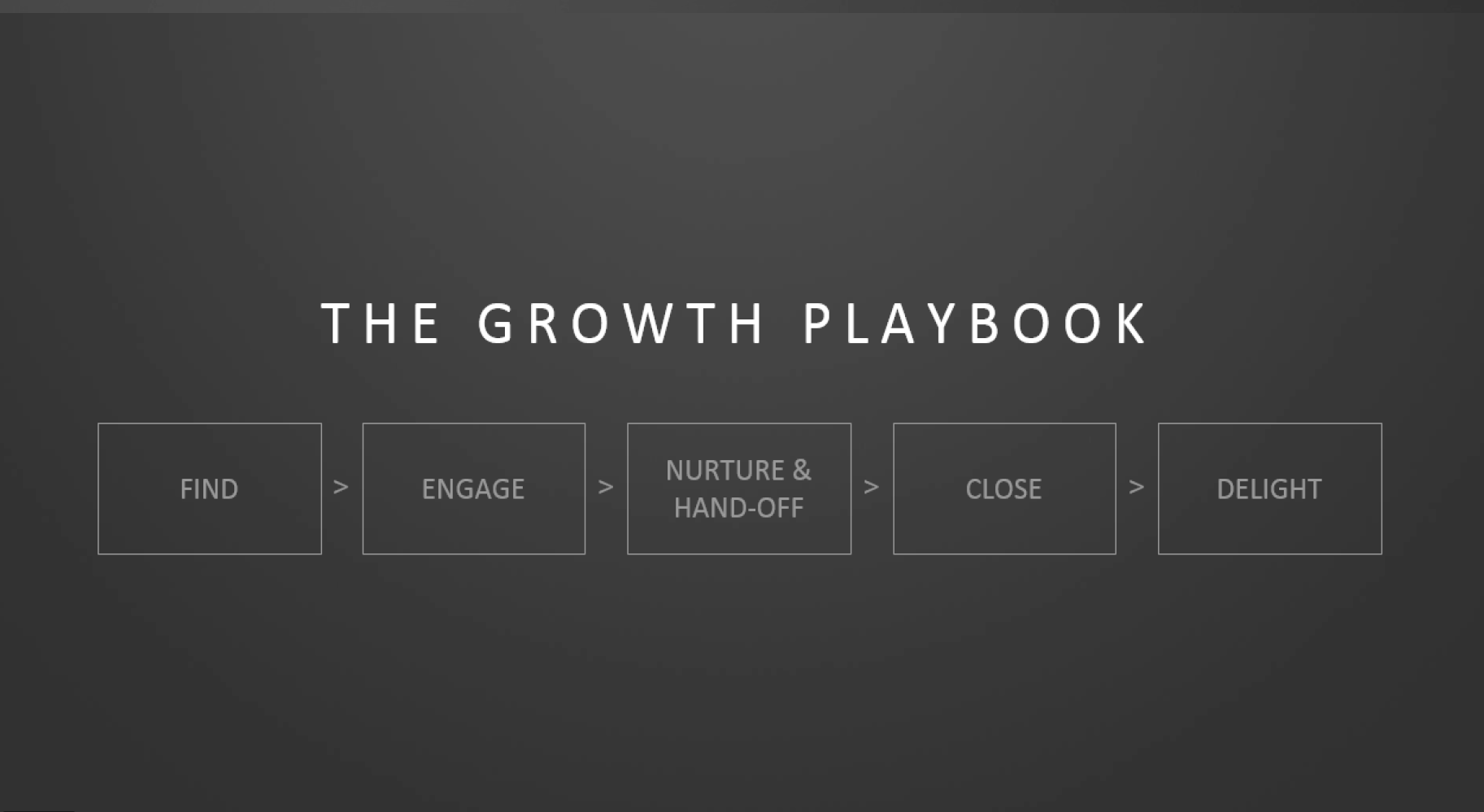
This is the growth playbook
HubSpot is all about helping you grow better and it's finding the right customers, it's engaging in a human way. It's nurturing the hand-off of Sales and Marketing. It's starting the relationship.
"We don't really close deals anymore. We start a relationship"
Then it's the delight process
There's lots of HubSpot products. All of them started free that help you support this process.
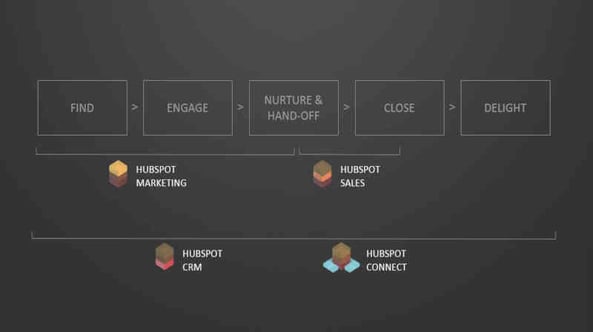
HubSpot Service Hub
Also the HubSpot Customer Service Hub, which is the customer service component of the growth stack is available as starting in May and any of the HubSpot partners will help you with that. Alright, so these are the free gifts that I want you to bring back to your Sales organisation.
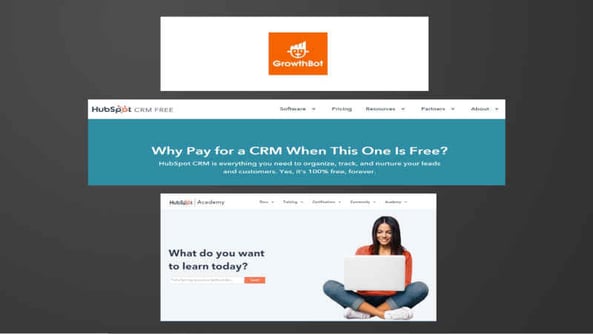
AI (artificial intelligence) for sales teams
The first thing I want you to ask them is... Has anybody sales organisations using artificial intelligence or machine learning? You can take out your cell phone right now. You can grab your Facebook messenger, you can get the GrowthBot in either Facebook Messenger or Slack.
What the growth bot will do is give your Sales team the ability to use artificial intelligence by asking certain questions that are delivered automatically. It's a Sales and Marketing bot, that will tell you
- who's buying certain keywords
- who's using certain software,
- help you identify certain users in certain geographic territories
- and of course, it's free
Number 2, if anybody needs a free CRM, the HubSpot CRM comes free. It'll always be free. And we have the HubSpot Sales free, which I will give you lead notifications, lead intelligence, and a meetings tool.
If you move to a paid product, I think it's $40 or $50 a month, the HubSpot Sales starter. But everybody can start at no charge to understand and get that competitive advantage.
HubSpot Academy
And then there's something called HubSpot Academy. Is anybody familiar with HubSpot Academy? Does anybody have a certification for HubSpot Academy?
So there are now 84 hours and 16 certifications. And so you can go in, it's free. You can give them to your Sales organisation. There's one called Inbound sales. And that will teach them all the things that I talked about today. It will take them 2 hours to watch. And then when they get the Inbound certification, when they take the class, they should put the Inbound certification on their LinkedIn.
Social selling is super important in 2018 and it helps.
The inbound organisation
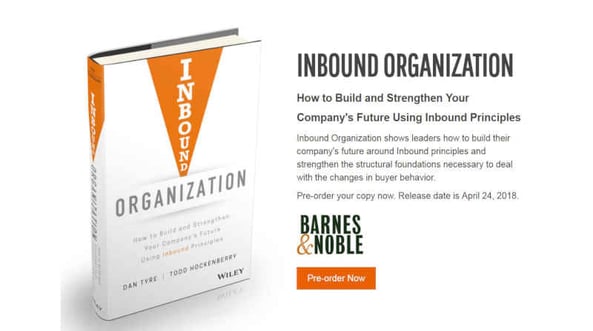
This is the book that I wrote a in 2017 available in April 24th 2018. It will help you explain to senior management how to build your own company, how to practice Inbound or how marketing alignment is important, how to lean into your customer experience.
There are four books from Hubspot coming out in April 24th
Inbound PR
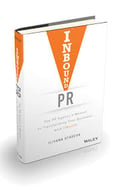
If you're a PR person, Inbound PR by Illyana Stareva, it is an awesome way of learning how to leverage Inbound for PR
Inbound content management
 Inbound Content Management by Justin Champion, a Hubspot trainer and talks about how Inbound content marketing works.
Inbound Content Management by Justin Champion, a Hubspot trainer and talks about how Inbound content marketing works.
Inbound Selling
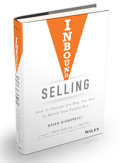 Brian Signorelli has Inbound Selling. It's a book you can hand to your vice president of Sales of how to practice Inbound through the Sales process.
Brian Signorelli has Inbound Selling. It's a book you can hand to your vice president of Sales of how to practice Inbound through the Sales process.
Brian Halligan, last year named the ninth rank highest CEO, super proud of that.
Any Grateful Dead fans in the audience? No, nobody. Anybody know who the Grateful Dead is? So, Brian is all about big impact and a Jerry Garcia, the lead guitarist of the Grateful Dead, they sold his guitar for 1.6/1.9 million dollars.
I'm reading that in Rolling Stone. I go: 'Who's stupid enough to pay 1.9 million dollars for a guitar?' It turns out it was Brian Halligan, right? And he took that money. It was doubled and he gave it all to the Southern Poverty Law Center to a fight hatred. Which is huge impact. I put it all in my presentation. Make me so proud. It's unbelievable.
HubSpot Diversity
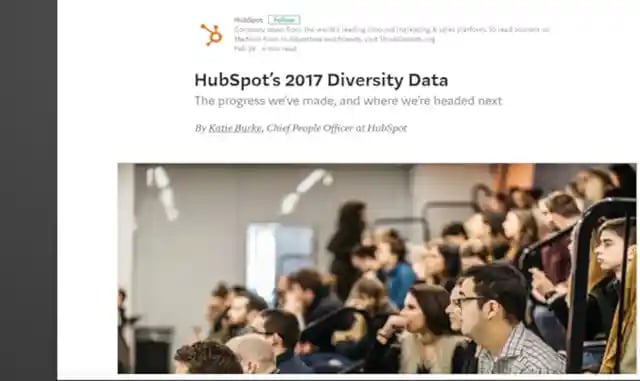
In addition, HubSpot today is all about inclusion and diversity, right? In 2006, we made a commitment to publicly post our diversity statistics. As the kind of company that wants to help. We have to lead, the reason we give you free stuff, we come on the road, we talk with you, we are all in to do anything that we can is because we're trying to change the world.
And so 2016 diversity statistics were okay. In 2017 HubSpot is now one of the top five tech companies in North America for gender equality. We have 3 women on our board of directors. Over 46% of our managers are women. And diversity and socioeconomic diversity continues to grow.
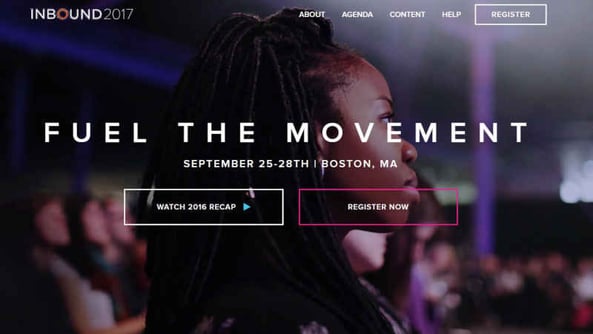
If you like this kind of stuff, how many people been to Inbound? Clwyd, I know, Pete. Yep. What's Inbound like? Great. What's a Inbound like? Yeah, that 20,000 people all like this. All nice people, incredible speakers. Incredibly inspiring. And there's a discount if you get your tickets before May 15th. All right.
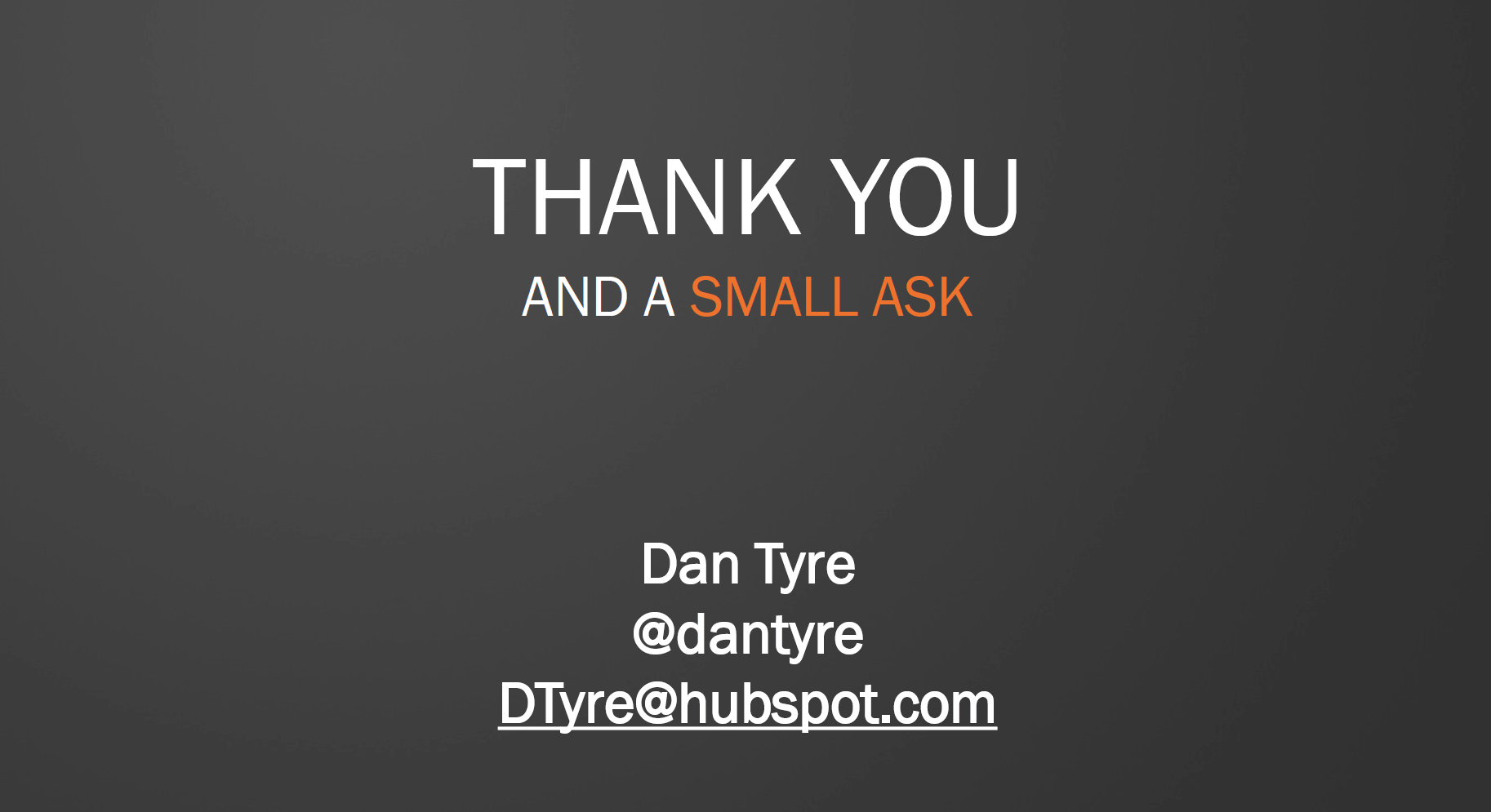
So you can connect with me at any point. You can email me. I've got a little bit limited bandwidth, but I guarantee I'll get back to you. What was my small ask? I was supposed to ask, to make sure that everybody fills out the survey there.
Well, thank you very much on behalf of HubSpot, HubSpot partners and our ecosystem community. Thanks for coming out today. It was thrilled to be here. Clwyd, thank you for putting it all together.


 When sales and marketing teams align, they create a formidable revenue engine that can drive business growth to new heights.
When sales and marketing teams align, they create a formidable revenue engine that can drive business growth to new heights. Effective communication is critical in the world of business. As someone who frequently speaks to diverse audiences around the globe, I've learned that what works in one culture might fall flat in another. This lesson is particularly poignant regarding humour, a powerful tool for engaging audiences and building rapport.
Effective communication is critical in the world of business. As someone who frequently speaks to diverse audiences around the globe, I've learned that what works in one culture might fall flat in another. This lesson is particularly poignant regarding humour, a powerful tool for engaging audiences and building rapport.
 Personal branding has become an essential aspect of professional success in today's interconnected world. As someone in the business world for decades, I've seen firsthand how a strong personal brand can open doors and create opportunities. Let me share some insights from my journey in personal branding and social media engagement.
Personal branding has become an essential aspect of professional success in today's interconnected world. As someone in the business world for decades, I've seen firsthand how a strong personal brand can open doors and create opportunities. Let me share some insights from my journey in personal branding and social media engagement.